Office Artwork
Contemporary Art at the Barr Foundation
In Barr’s office space at Two Atlantic Avenue and in the historic Pilot House, we are privileged to showcase the work of contemporary artists. The artists represented in this curated collection have socially-engaged practices. They share the distinct ability to generate rigorous discourse using the lightest touch and delivered through the most beautiful vehicles—their works of art.
The work in this collection looks to the world around us, often using the most everyday materials to transformative ends. Some of the pieces engage with the history of 20th-century art and focus on the creative process itself. Others focus on our natural environment and seek to propel a greater awareness of our impact on that environment as communities and humans. Many of the artists are also teachers, and much of the work explores the transfer of knowledge or cultural heritage.
Artists
El Anatsui
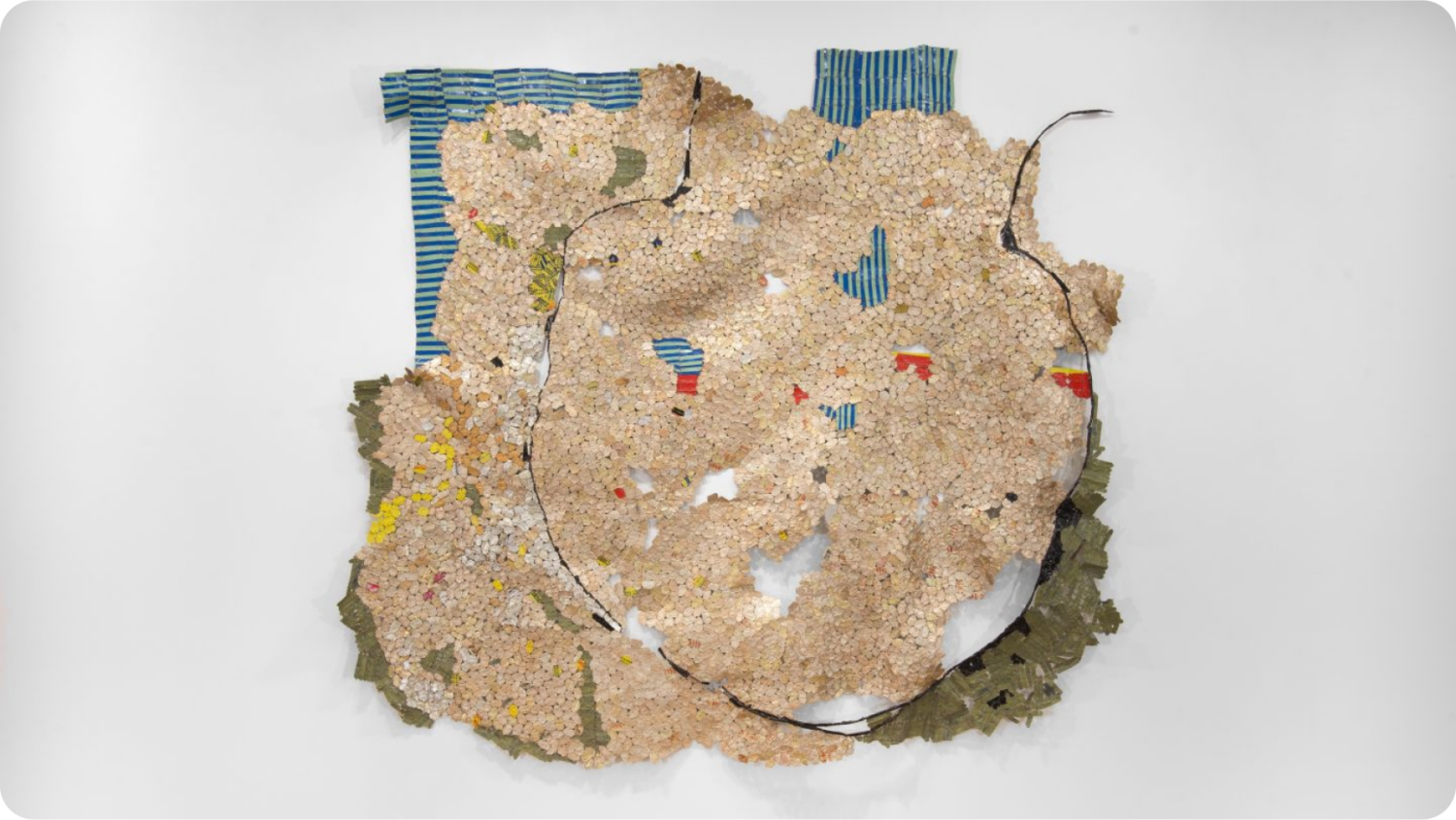
Flimsy Excuse. Material: Aluminum and copper wire. Year: 2016. Size: 96 x 108 inches. © El Anatsui. Courtesy of the artist and Jack Shainman Gallery, New York.
El Anatsui was born in Ghana and now splits his time between Ghana and Nigeria. For much of his career, he taught sculpture in Nigeria. Anatsui transforms everyday aluminum bottle tops, acquired from a local alcohol recycling center, into luminous and complex assemblages. He threads the flattened aluminum with copper wire, constructing wall sculptures that evoke tapestry, mosaic, fragility—but also the protectiveness of chain mail—and the natural environment. His focus on the destruction and reconstruction of materials indicates his interest in transformation, consumption, and the environment, but also serves as a metaphor for life and changes in Africa. Anatsui’s artistic language is rooted in his region and is capable of engaging with such weighty topics as the history of colonialism. At the same time, his assemblages transcend the limitations of place by their sheer beauty and evocation of a variety of materials and sensations. In 2015, Anatsui was awarded the Golden Lion for Lifetime Achievement, the Venice Biennale’s highest honor.
Carol Bove
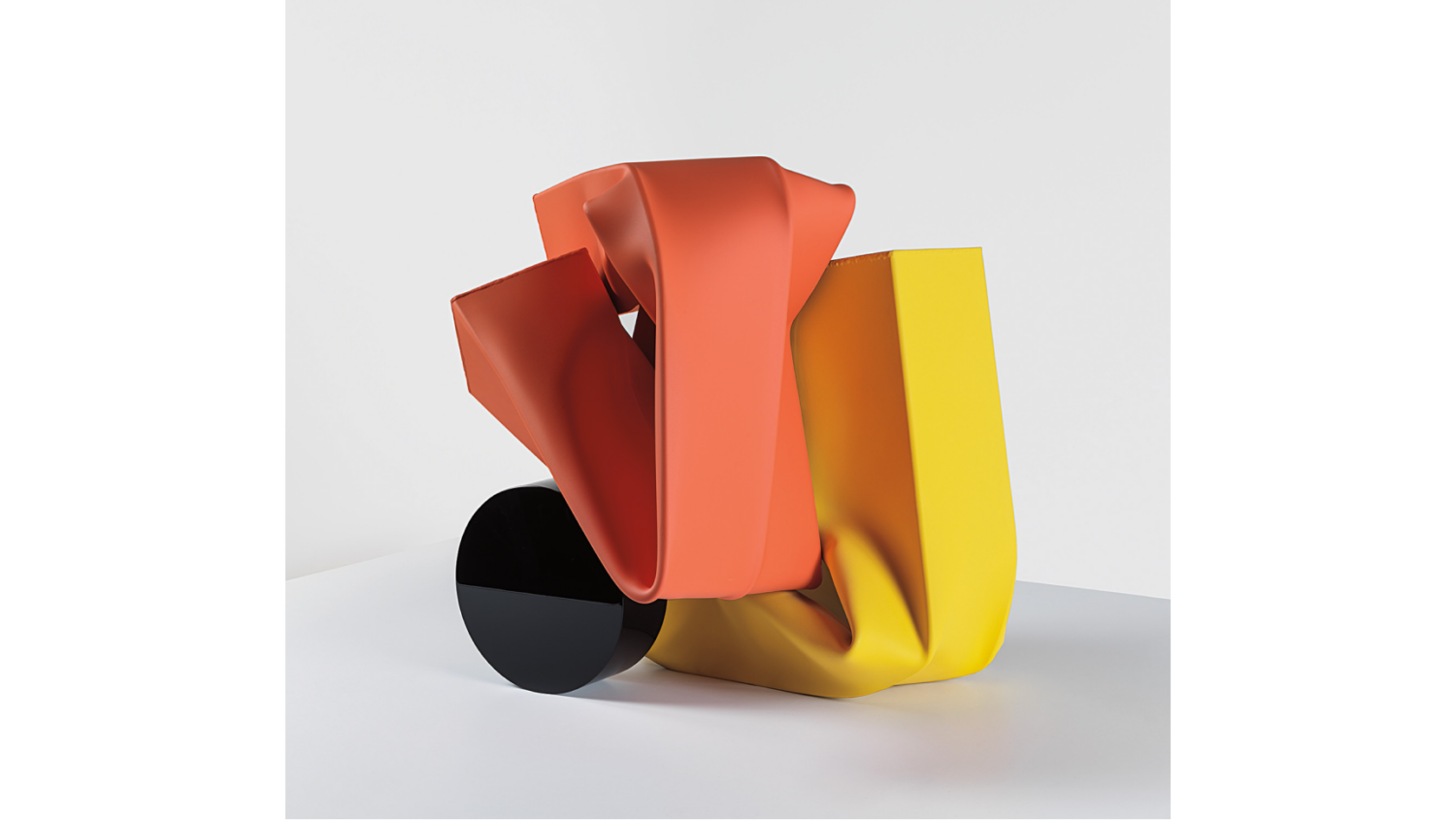
Young Lovers. Material: Stainless steel and urethane paint, in 2 parts. Year: 2018. Size: 22 x 21 x 22 inches. © Carol Bove, courtesy of the artist and David Zwirner.
American artist Carol Bove is known primarily for sculpture that combines found and made elements. She describes her recent abstract steel compositions as “collage sculptures”. Her thoughtful juxtaposition of objects allows the viewer to focus on the poetry of her materials. In Young Lovers Bove has crushed and shaped square steel tubing – scrap metal that she finds near her Red Hook studio – and painted it a vivid yellow and orange. The tubing rests casually against a black highly polished disk. In Bove’s hands, the rigid steel appears clay-like and malleable, the disparate elements full of personality.
María Magdalena Campos-Pons
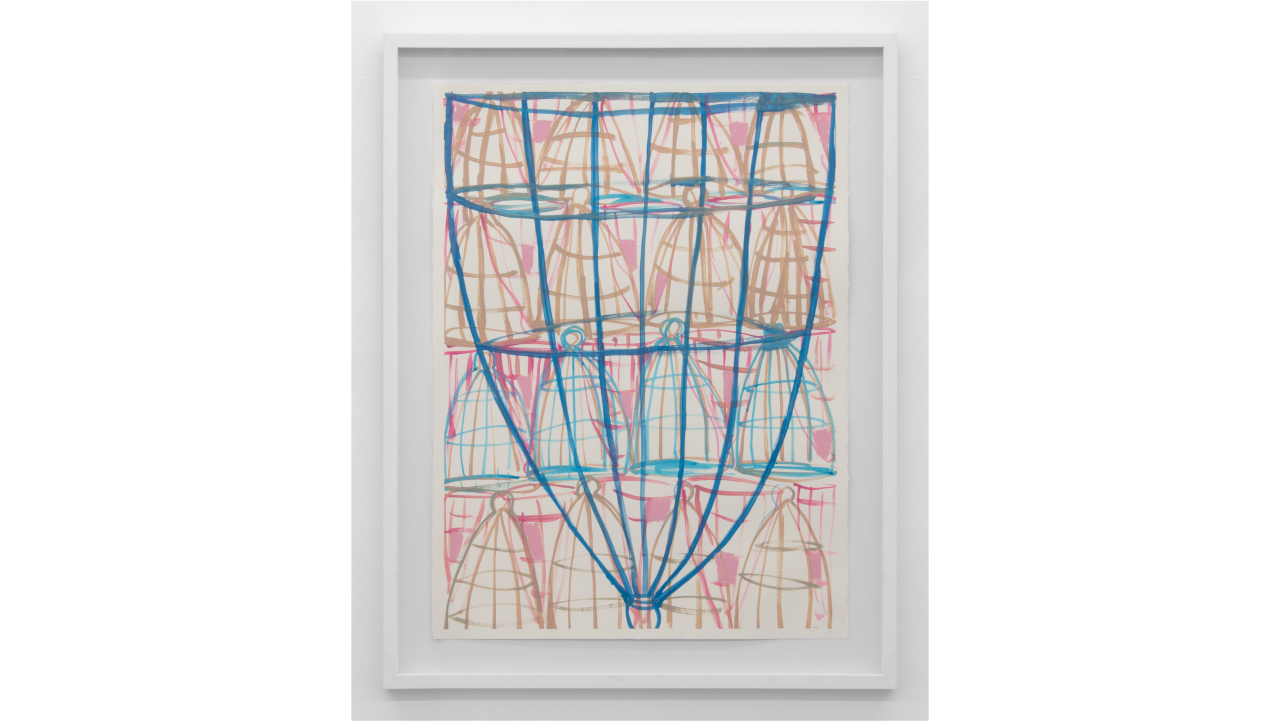
Letter of the Year IX. Material: Watercolor, gouache, oil stick, and graphite on paper. Year: 2013. Size: 35 x 27 inches.
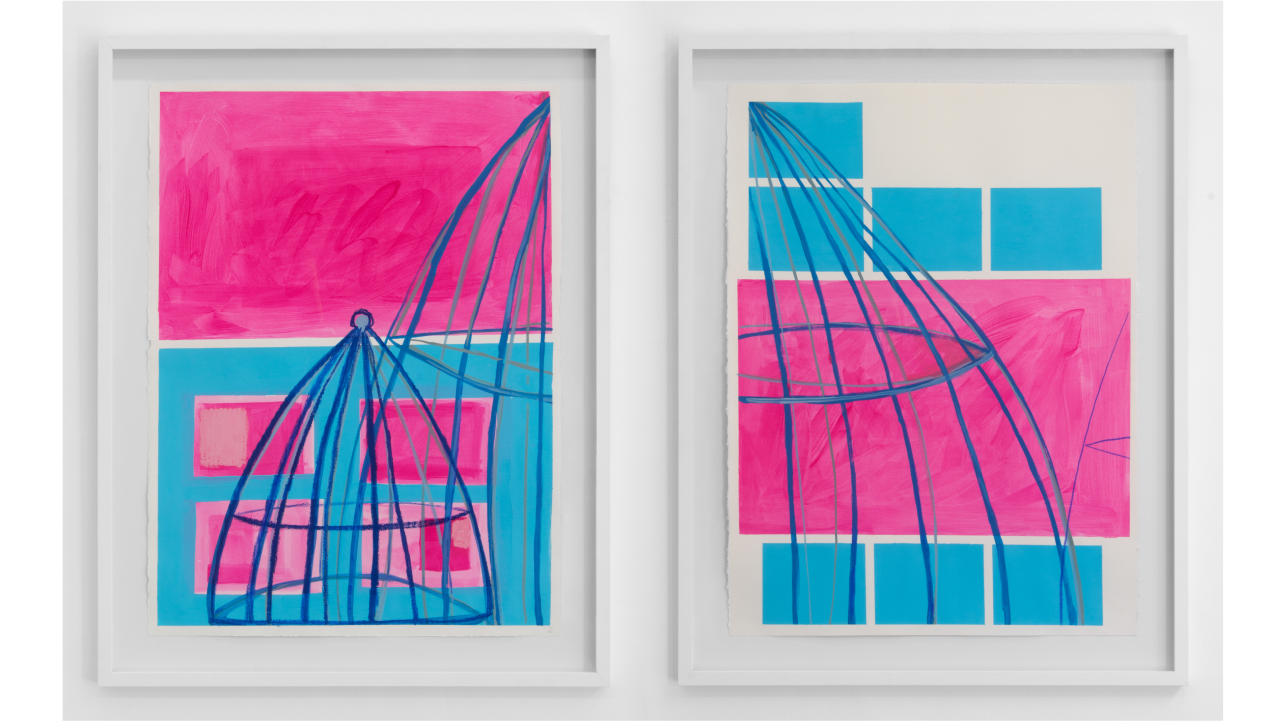
Letter of the Year X. Diptych. Material: Watercolor, gouache, oil stick, archival artist tape and graphite on paper. Year: 2013. Size: 35 x 27 inches each.
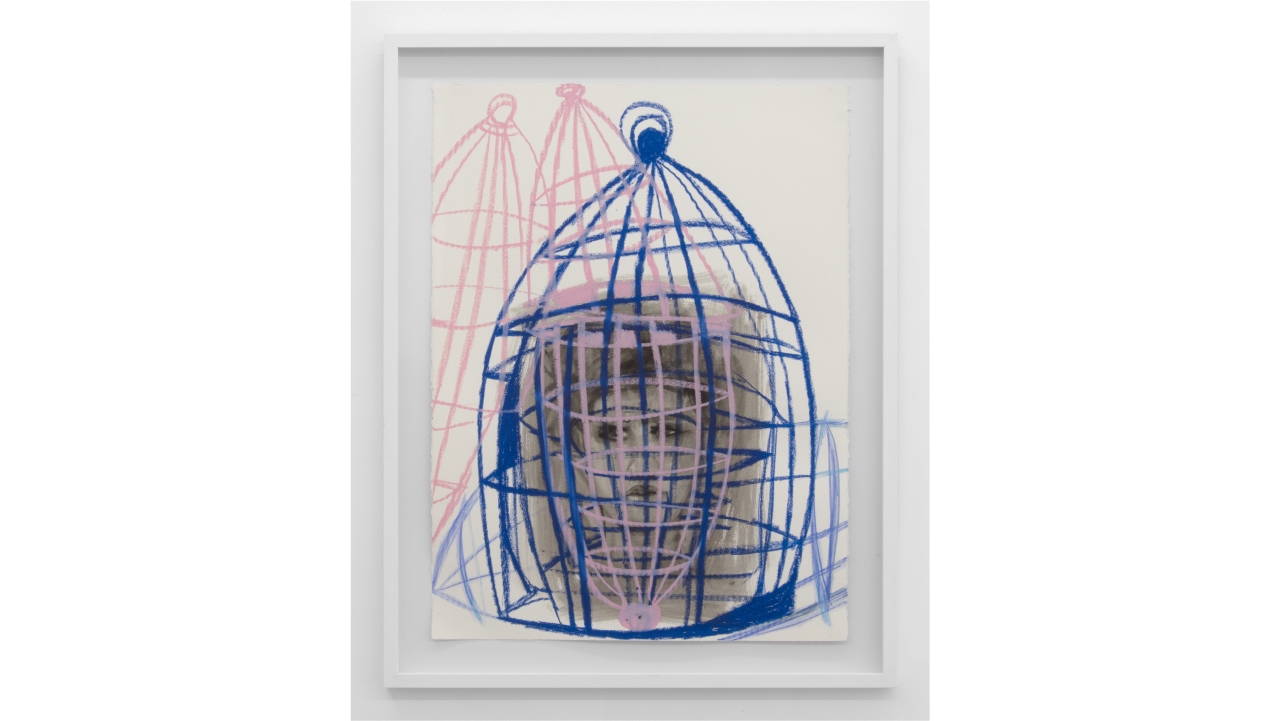
Letter of the Year V. Material: Watercolor, gouache, oil stick, and graphite on paper. Year: 2013. Size: 35 x 27 inches. Courtesy of the artist and Samsøñ.
Letter of the Year
Cuban artist María Magdalena Campos-Pons has lived and worked in Boston since 1991 and is on the full-time faculty of the School of the Museum of Fine Arts, Boston. She has been exhibiting her installation art, performance, documentary photography, and cultural activism internationally since the early 1980s. Her work is often autobiographical, focused on her Afro-Cuban heritage that is intermingled with the sugar industry’s presence in Cuba. At the same time, she notes: “My work renders elements of personal history and persona that have universal relevance…My themes are cross cultural, and cross generational.” Her work is an investigation of history and memory, and their roles in the formation of identity.
This series of works on paper, entitled 53+1=54+1=55/Letter of the Year, were produced in conjunction with Campos-Pons’ installation at the 55th Venice Biennale. The project was produced in collaboration with composer Neil Leonard and located in the Emperor’s Room in the Piazza San Marco’s Archeology Museum.
The installation comprised a continuous mass of woven wicker birdcages, housing video monitors and discrete speakers playing footage and audio of Havana street life. The birdcages represented both physical aspects of the cityscape, as well as signified concepts of freedom and confinement. Set against the backdrop of busts depicting Roman emperors, the moving images, sounds and structures of the installation juxtaposed Afro-Cuban culture with objects of classical, Western political imagery. The related works on paper act as visualizations of the artist’s sculptural and performative installation.
Peter Downsbrough
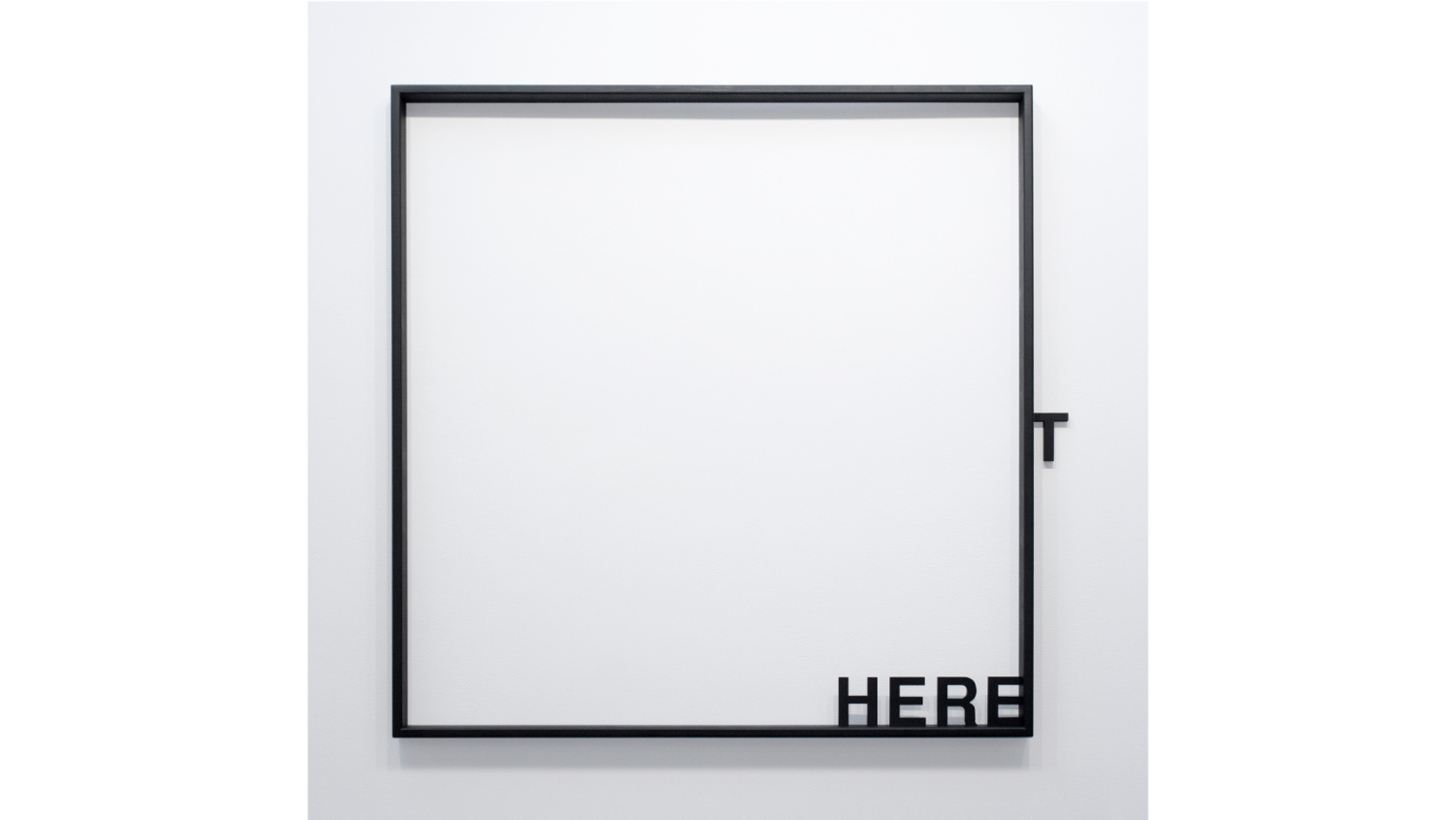
T/HERE. Material: Painted metal. Year: 2016. Size: 40 x 42 inches. © 2017 the artist, image courtesy of Krakow Witkin Gallery, Boston.
T/HERE
American artist Peter Downsbrough now lives and works in Brussels, Belgium. Since the 1970s, he has developed a radically reduced visual vocabulary that he uses to investigate the given space in a very precise way. His vocabulary consists of letters and lines that he applies to walls, ceilings, and floors. The letters form conjunctions, pronouns, verbs, and nouns. The lines emphasize an architectural detail or accentuate a space. Areas defined by lines, such as the square in T/HERE, sometimes also play a role and reveal a new interior space. Downsbrough’s work has a sly humor and demands interaction with the viewer, despite such minimal means. The physical definition of space by the metal bars is complemented by the metaphorical directions prompted in the viewer’s mind by the words. When installed in a given interior, T/HERE articulates the architecture of a room. “Here” is contained within a defined area. “There” is outside of the box yet does not exist without “Here.”
Jeffrey Gibson
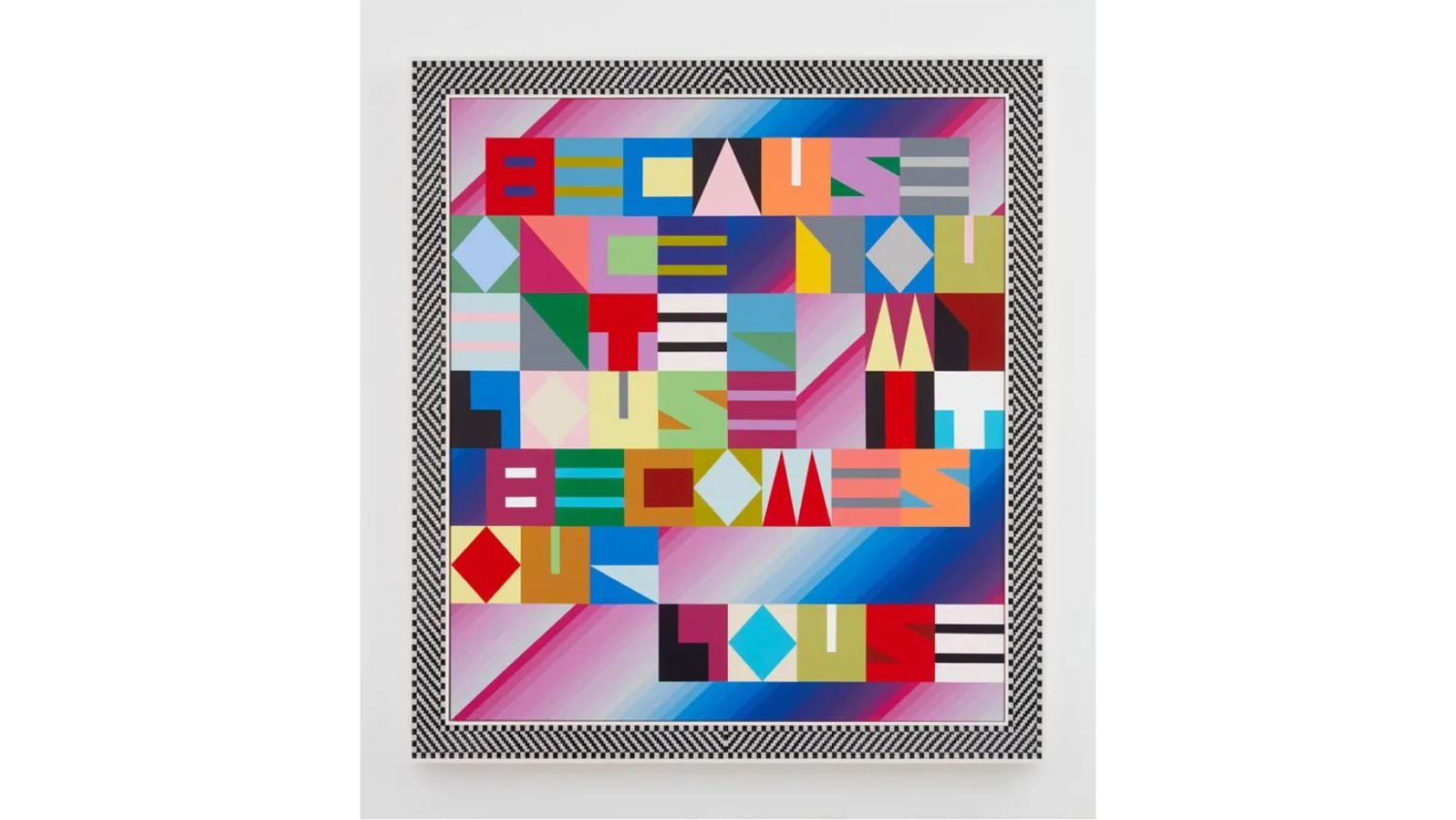
Because Once You Enter My House It Becomes Our House. Material: Acrylic on canvas, glass beads and artificial sinew inset into wood frame. Year: 2018. Size: 82 x 74 x 2.5 inches. © Jeffrey Gibson, courtesy of Sikkema Jenkins & Co.
Jeffrey Gibson grew up in major urban centers in the United States, Germany, Korea, and England. He is a citizen of the Mississippi Band of Choctaw Indians and is half Cherokee. His artistic vocabulary references his heritage and international upbringing alongside a formal geometric abstraction. Further layered within these concerns is text appropriated from song lyrics, specifically from songs Gibson heard while clubbing in the 80s and 90s in venues around the world. By starting from a deeply personal and specific set of references, Gibson’s paintings and sculptures investigate universal issues of race, sexuality, religion, and gender.
Mike Glier
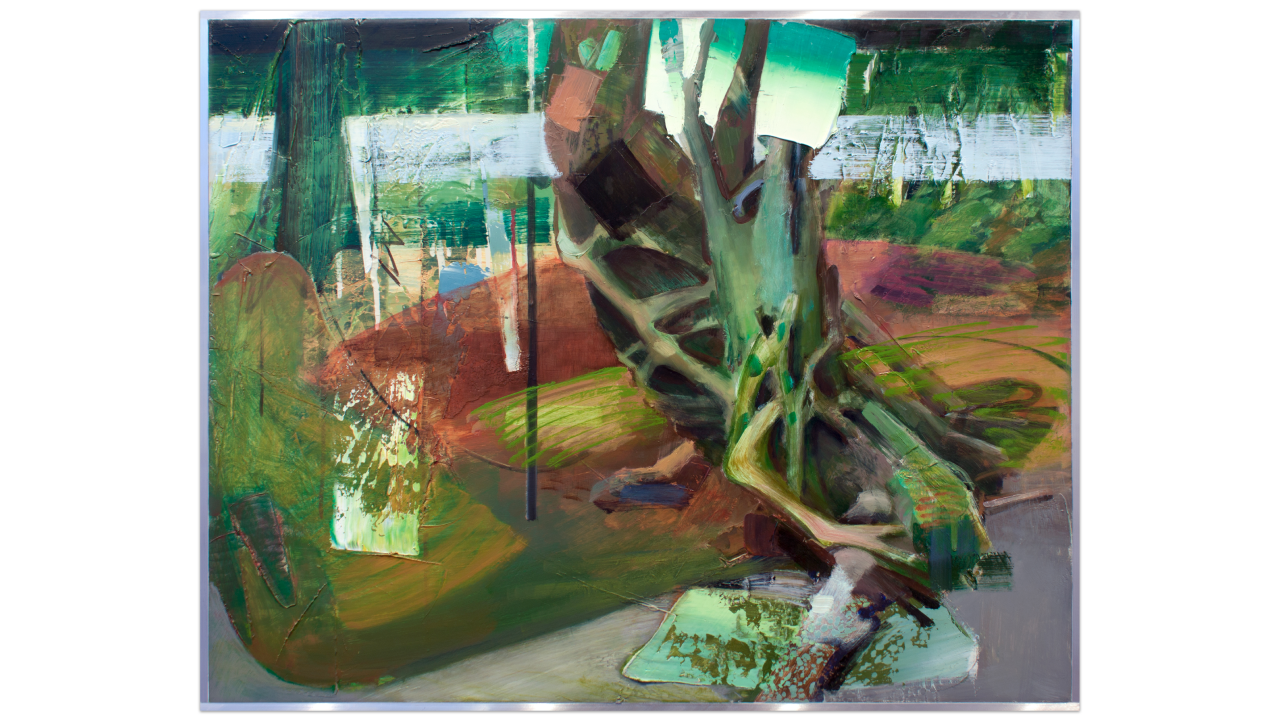
December 3, 2007: Equatorial Rainforest, San Cudo, Ecuador, 90ºF. Material: Oil on aluminum panel. Year: 2007. Size: 24 x 30 inches.
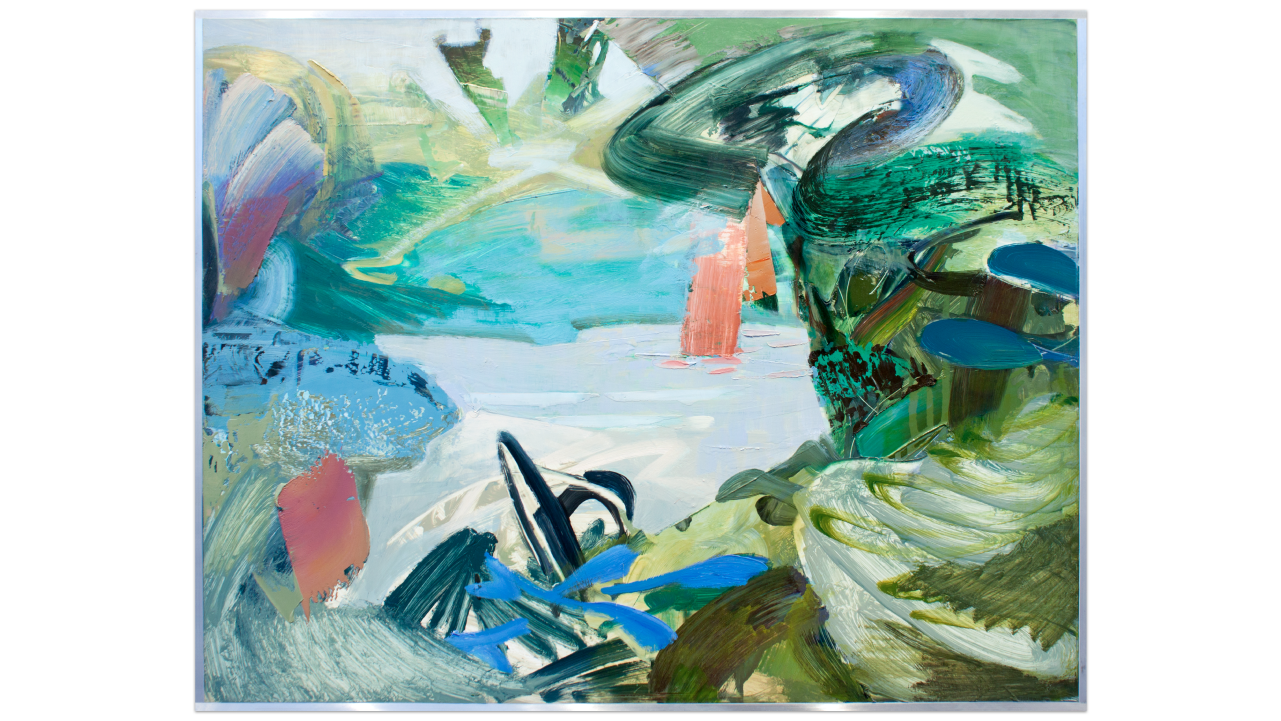
January 23, 2008: Afternoon at Haulover Bay, St. John, Virgin Islands, 83ºF. Material: Oil on aluminum panel. Year: 2008. Size: 24 x 30 inches.
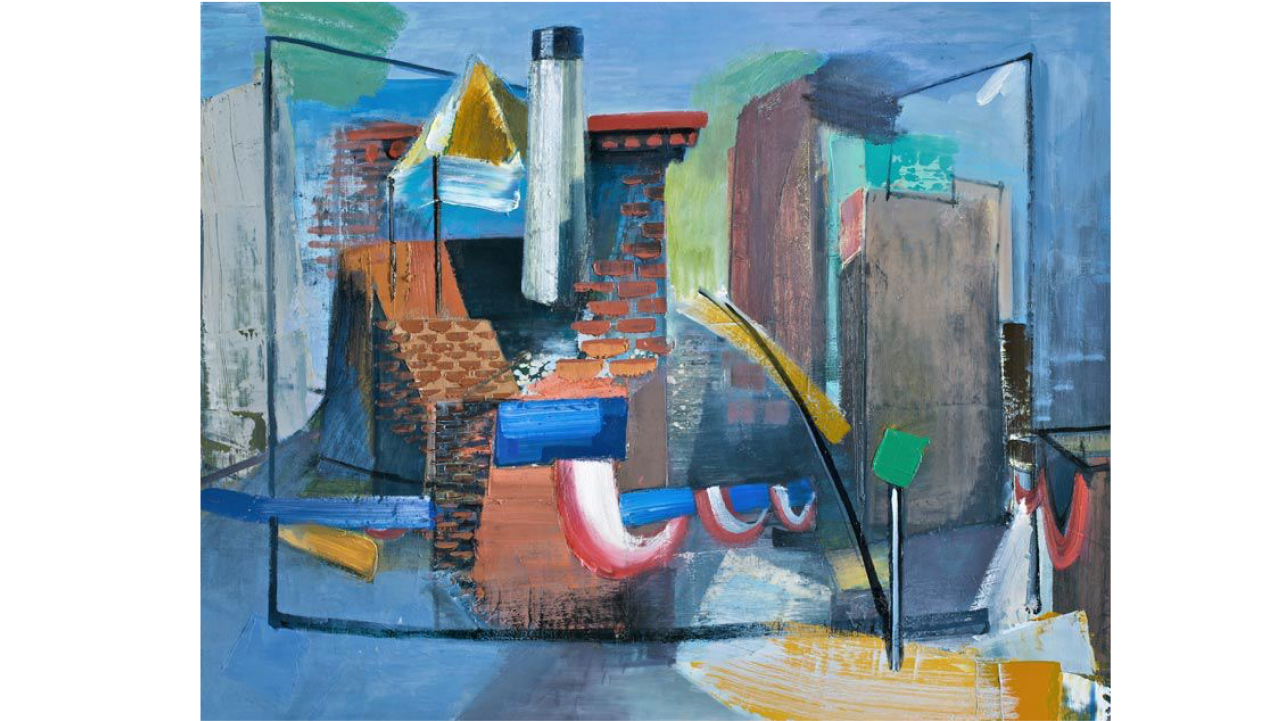
April 2, 2008: Avenue C, New York, New York, 50ºF. Material: Oil on aluminum panel. Year: 2008. Size: 24 x 30 inches.
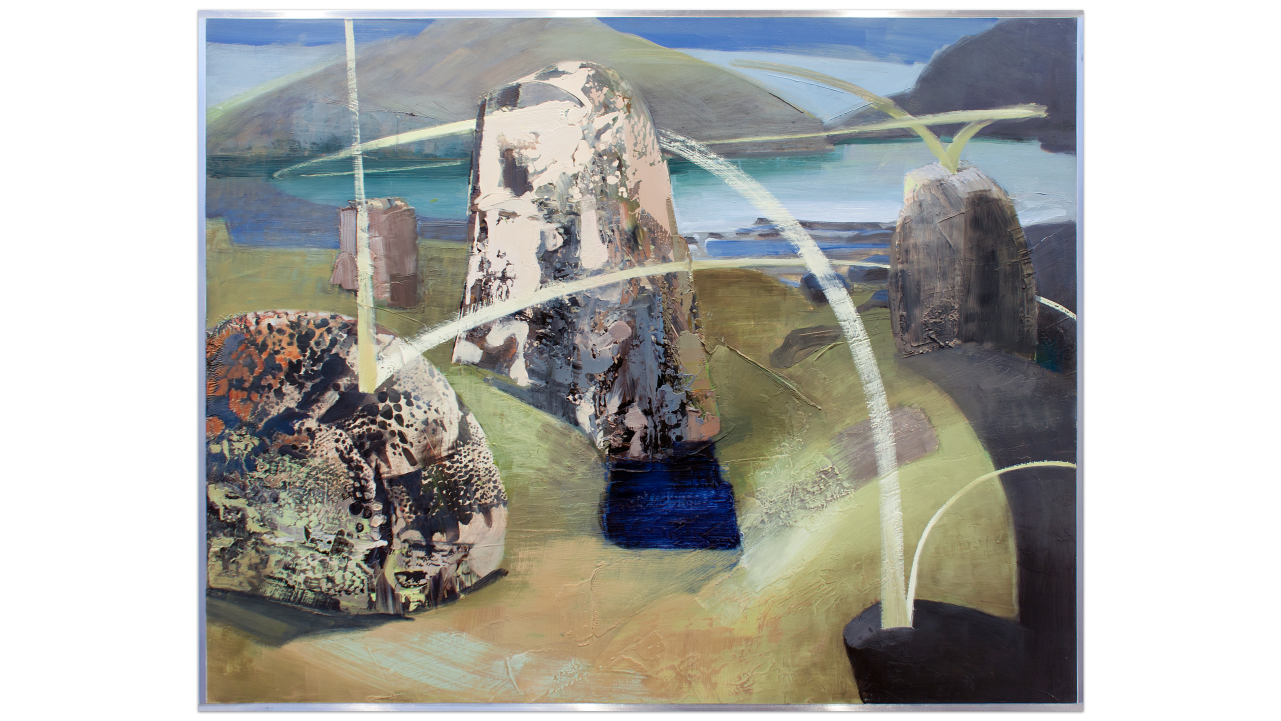
July 9, 2007: Pink Granite, Pangnirtung, Canada, 45ºF. Material: Oil on aluminum panel. Year: 2007. Size: 24 x 30 inches. © 2017 the artist, image courtesy of Krakow Witkin Gallery, Boston.
Along a Long Line
American artist Mike Glier lives in Hoosick Falls, New York, and is a professor of Art at Williams College in Williamstown, Massachusetts. For the past 15 years, he has pursued a global, plein air painting project. Between 2007 and 2008, he followed the 70th longitude, beginning at the Arctic Circle and ending at the Equator. The project, Along a Long Line, resulted in a set of paintings (and one book) from each of four stops: the Inuit village Pangnirtung on a fjord very near the Arctic Circle; the ecological preserve Jatun Sacha Reserve near San Cudo, Ecuador; the Virgin Islands National Park, which has been designated by the United Nations as a part of the biosphere reserve network; and New York City. In each location, Glier painted his panels outdoors in the tradition of plein air Impressionism but driven by a very contemporary social and environmental activism. Glier states: “Marking a point, drawing an arc, and implying a diameter, [this project] visualize[s] the earth as a shared space, sectioned by scientific measure rather than political boundaries.” Along a Long Line prompts us to connect the dots between these diverse ecosystems and literally trace the connection between them.
Olafur Eliasson
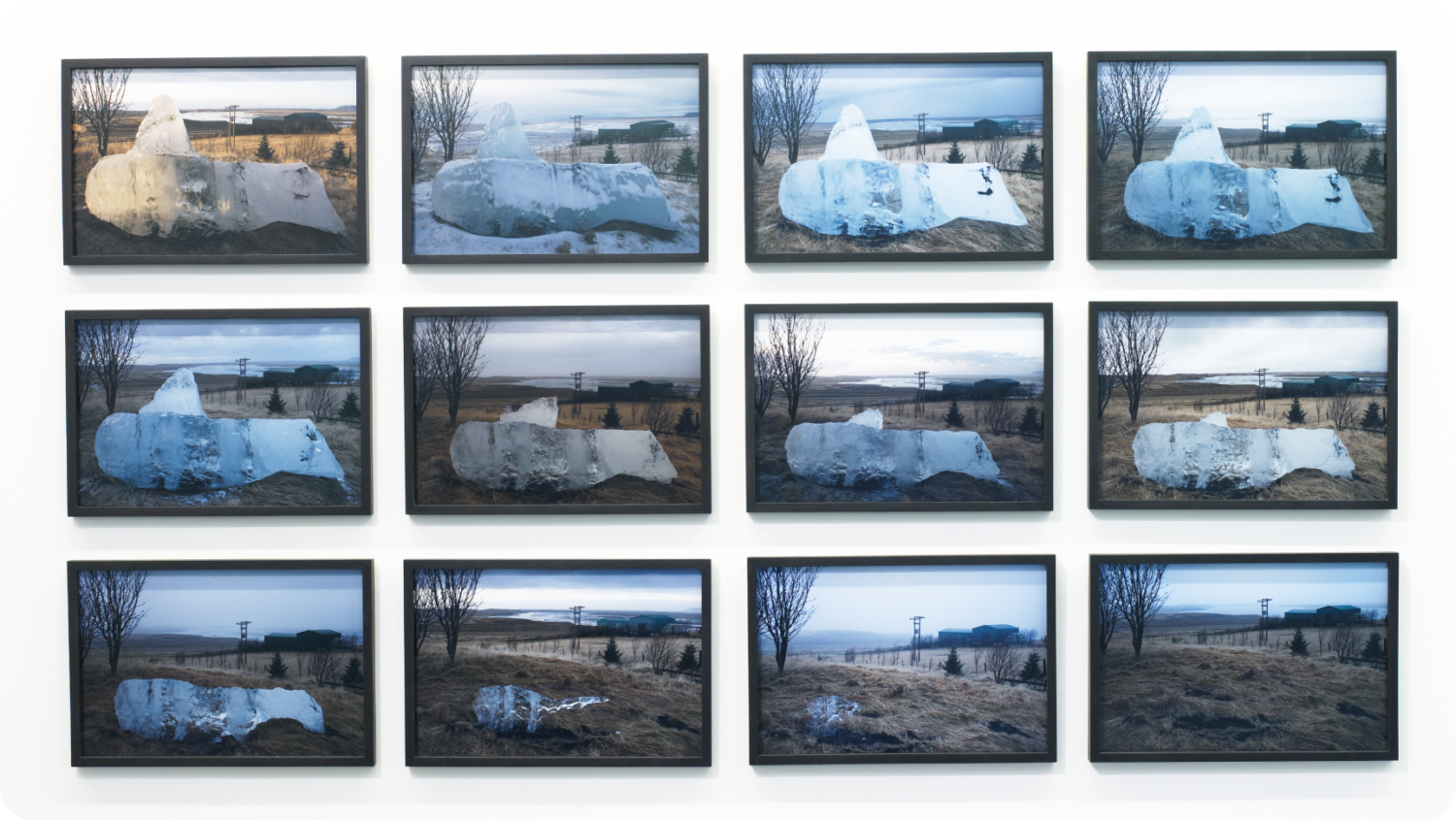
Melting ice on Gunnars land. Material: 12 c-prints. Year: 2008. Size each: 9 1/2 x 14 inches; 24 x 35.5 cm (framed). Size overall: 32 1/4 x 60 1/2 inches; 82 x 154 cm. Edition of 6; 1 AP. Courtesy the artist and Tanya Bonakdar Gallery, New York
Olafur Eliasson is an Icelandic/Danish artist interested in movement, light, and atmosphere, and in the viewer’s perception and experience of those. His work is socially motivated and he strives to make art that is relevant to society at large. In this series of photographs, as in much of his work, he focuses on environmental issues and humans’ impact on the environment, but with a light and deft touch. The photographs simply show a large block of ice melting in an Icelandic landscape. As viewers’ eyes move through the sequence of images, they might ask how this large piece of ice came to rest in this field, should it be there, should it be melting; and because the title tells us that it is on Gunnar’s land, we understand that humans have had an impact on this landscape. The straight documentary style of the photographs do all the work of engaging viewers and generating a greater sense of awareness of how our actions impact our environment.
Michelle Grabner
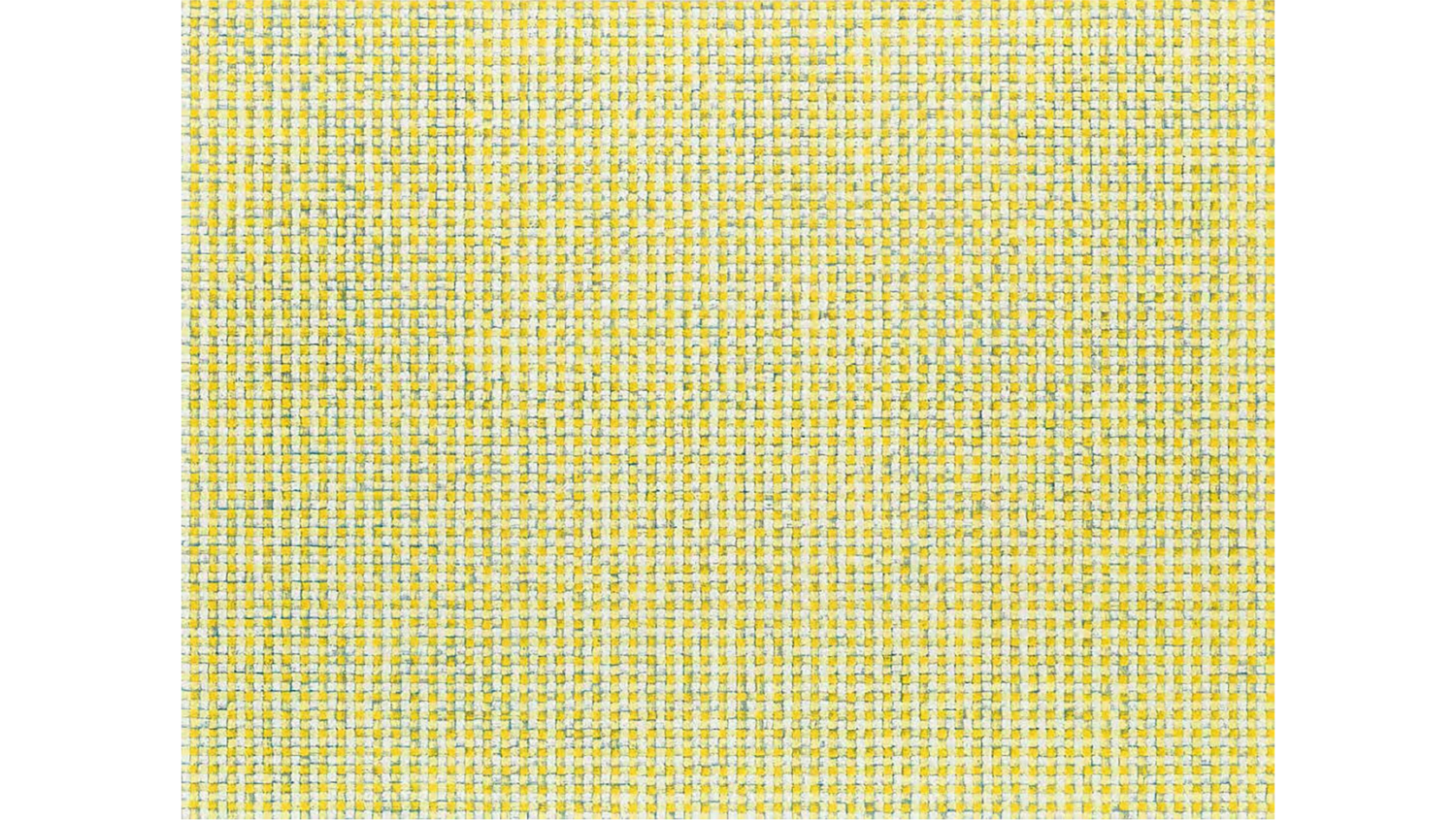
Untitled. Material: Oil and gesso on burlap and panel. Year: 2016. Size: 90 x 120 in. (228.6 x 304.8 cm). © Michelle Grabner. Courtesy James Cohan, New York.
American artist Michelle Grabner’s artistic engagement includes a studio practice, curation, writing, and education. Her role as an educator is, in her mind, equal to her work in drawing, painting, video, and sculpture. She has been the chair of the Painting and Drawing Department at The Art Institute of Chicago since 2009, and she is also a senior critic at the Yale University Art Gallery. She began developing her pattern paintings 20 years ago when her young son brought a construction paper weaving home from school. This work is fundamentally process-based, her motivations resting in a desire to identify and subsequently reproduce patterns. The larger-than-life scale of Untitled invites viewers to stand close and envelope their range of vision with the pattern. Grabner’s masterful paint handling and patience in reproducing the mundane pattern then also becomes clear. On the other hand, the patterns she chooses signify a commonplace, even domestic, sphere—the weaves most recognizable as table cloths, cloth napkins, or bed linens. Artist and colleague Molly Zuckerman-Hartung admires Grabner’s “commitment to producing a body of work minimal enough to allow projection and profound enough to invite immersion.”
Tanja Alexia Hollander
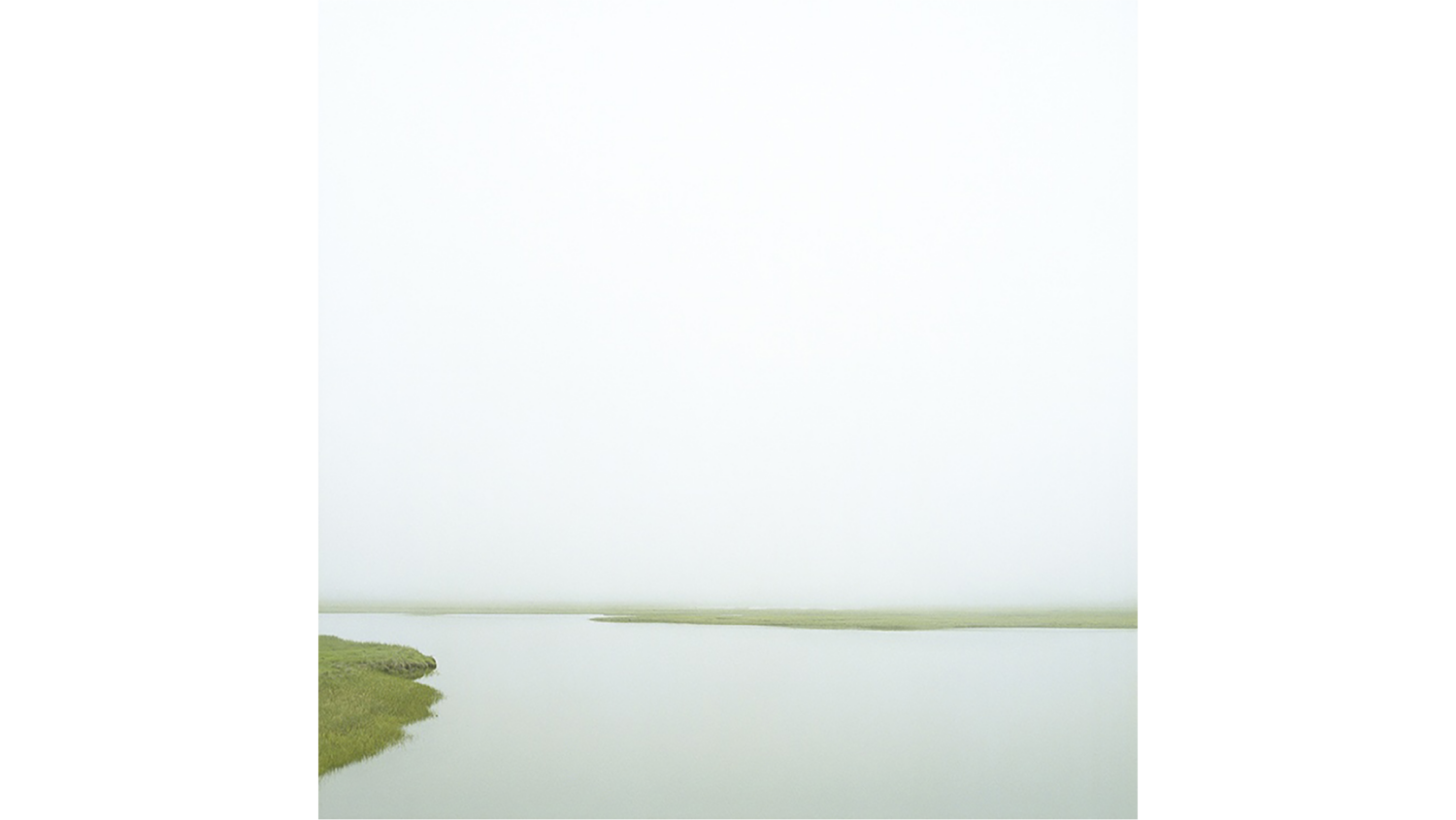
Untitled 141812 (Wells, Maine). Material: Archival pigment print. Year: 2014. Size: 44 x 44 inches. © Tanja Hollander. Courtesy Carroll & Sons, Boston
In 2011, the Maine-based artist Tanja Hollander set out to photograph all 626 of her Facebook friends, some of whom she had never met in person. The series, titled Are You Really My Friend?, explores the meaning of community and friendship in the age of social-media. The resultant body of photography was shown in its entirety at Mass MoCA, North Adams, MA in 2017. In pursuing her in-person meetings in her friends’ homes, Hollander simultaneously engaged with an American photographic tradition of documentary photography of place. Her global travels inspired her to return to an earlier preoccupation with landscape photography. Untitled 141812 (Wells, Maine) was taken during her travels for Are You Really My Friend? and keeps the same square format – perhaps most familiar to us today through Instagram – as the portraits. Taken alone, it is a meditative work of quiet beauty. Considered within the context of the larger project, it also explores the relationship between technology and travel, and the way in which our private lives and travels are shared publicly.
Bronlyn Jones
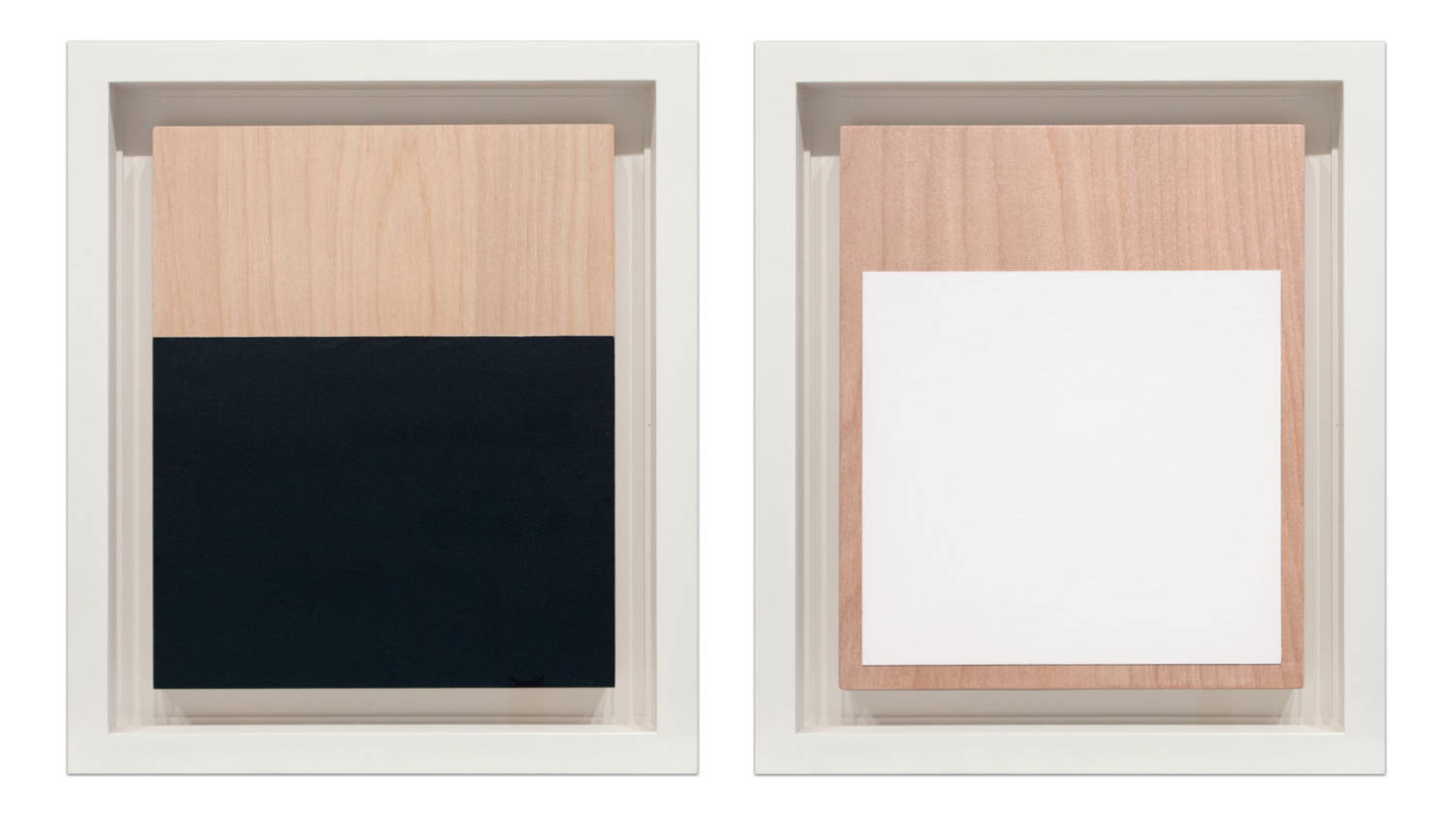
Untitled. Material: Black and white gesso on paper mounted on a ¾” birch panel in artist’s frame in two parts. Year: 2016. Size: Panel size 8 ½ x 7 inches each; Frames size 11 x 9 ½ x 2 inches each. © 2017 the artist, image courtesy of Krakow Witkin Gallery, Boston.
American artist Bronlyn Jones has lived and worked in New England for most of her career. Her artistic origins are in photography, and the use of positive and negative space continues to drive her practice since moving into drawing and painting in the 1990s. In her paintings, Jones chooses particular sections of grains of wood from larger sheets. She carefully adheres paper to the panels, which she has sparingly and precisely painted with gesso. The proportions of paper to panel, frame depth, and spacing between parts is all specifically chosen. Jones’ work rewards time spent viewing and experiencing. Despite the precision of the relationships between materials, occasional uneven painted edges on the artist’s frame or paper remind us of the human hand that created the object. Her work is a meditation on choice, control, and chance.
Jennie C. Jones
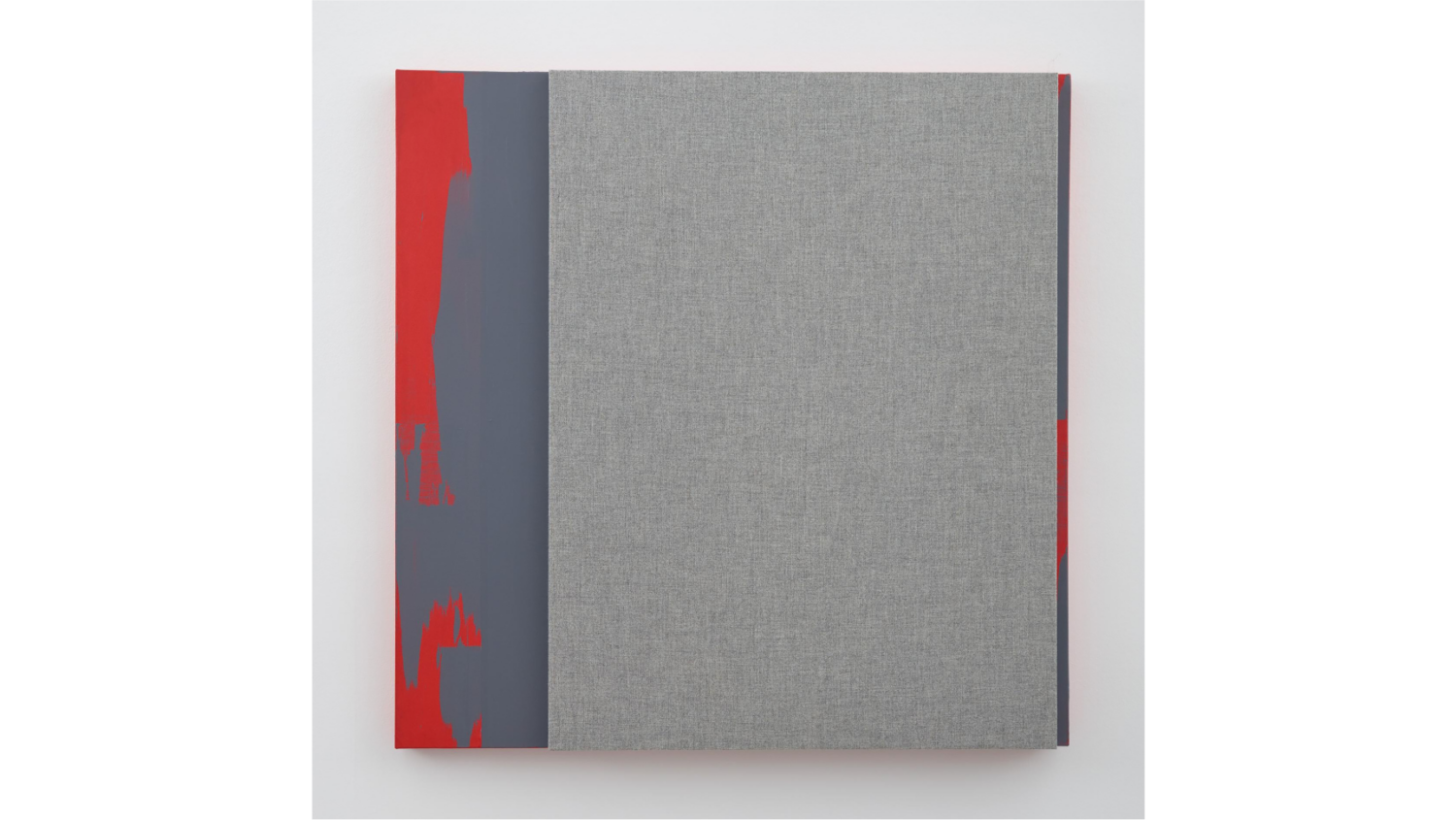
Red Recording Gray (for Elvin Jones). Material: Acoustic absorber panel and acrylic paint. Year: 2016. Size: 48 x 48 inches (121.9 x 121.9 cm). © Jennie C. Jones, courtesy of Sikkema Jenkins & Co., New York.
American artist Jennie C. Jones attends to sound alongside sight in her “acoustic paintings.” The paintings are constructed from industrial sound absorbing panels and acrylic paint on board. Her choice of material literally denotes noise or the muffling of noise. In addition, she uses red as an activation color in the same manner that the “Record” button on recording equipment or “On Air” light in DJ booths indicate sound is being produced. The muted grey tones in contrast to the red seem to visually suggest silence in contrast to the more vibrant indication of noise. Conceptually Jones draws from visual traditions of abstraction and minimalism and from a musical jazz tradition. She frequently uses iconic phrasing from experimental jazz compositions and solos, often deconstructed, as an aural element to her installations. Even without the literal sound, Jones’s paintings suggest an expectation of it—they become a visual representation of silence and noise.
Jaclyn Kain
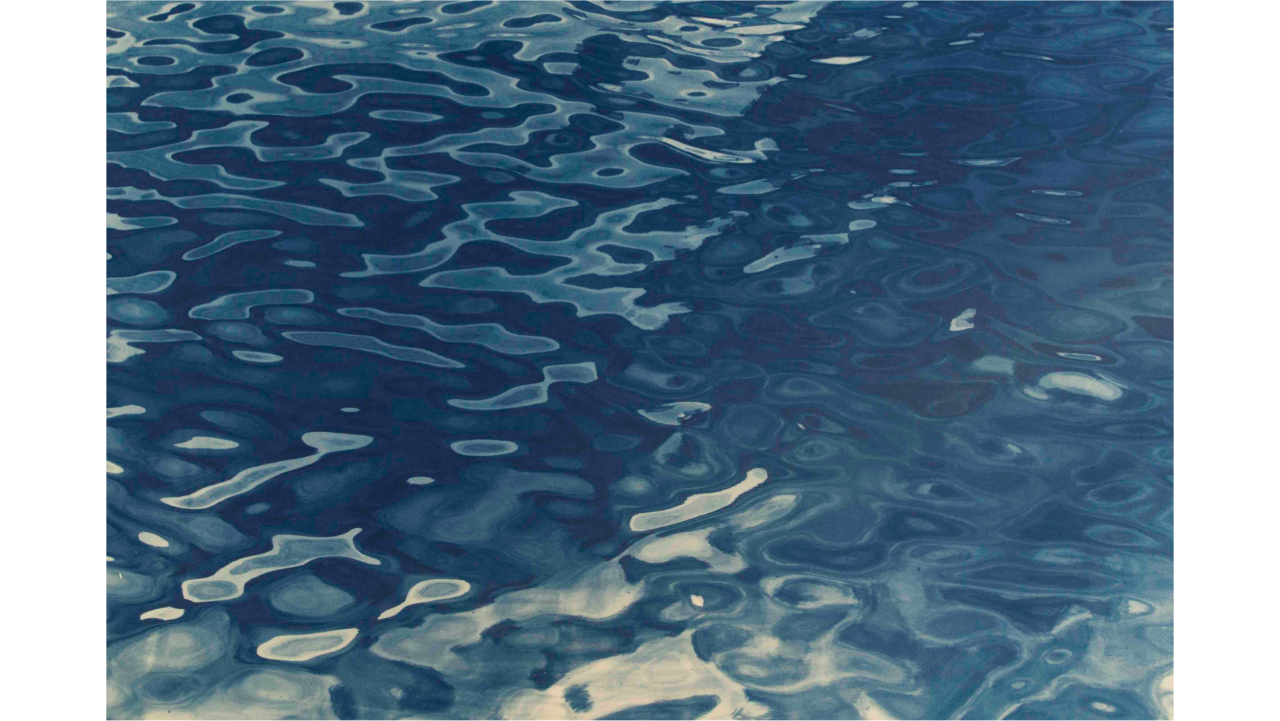
Water Surface #2. Material: Cyanotype. Year: 2016. Edition: 2 of 3. Size: 18.5 x 28 inches.
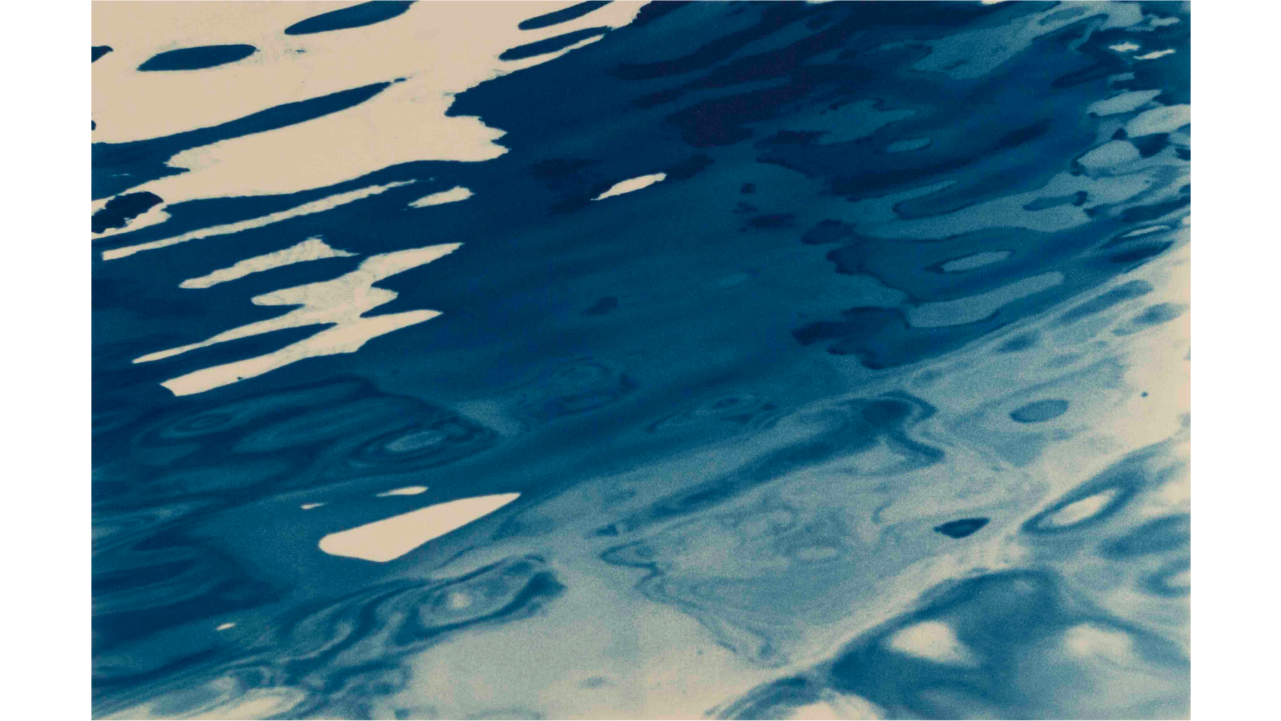
Water Surface #27. Material: Cyanotype. Year: 2016. Edition: 1 of 3. Size: 18.5 x 28 inches. Image courtesy of the artist and Gallery NAGA.
Water Surface
Boston-based artist Jaclyn Kain intertwines subject matter with medium in her photographs of Boston Harbor. Cyanotype is a contact-printed photographic process that involves painting a light-sensitive medium on any absorbent surface, such as paper. The print is exposed in the sun and requires only sunlight and water to develop. The process produces a cyan-blue print. Kain closely crops her images of Boston Harbor, emphasizing the play of light on the water’s surface. Without a visible horizon line or identifying cityscape, the image becomes highly abstracted, a surface patterning of light and dark rather than volume or place. Kain’s photographs capture the elusive shifts of sunlight on moving water. In the cyanotype, these same elements of sunlight and water in turn develop the fixed image on the paper.
Masako Kamiya
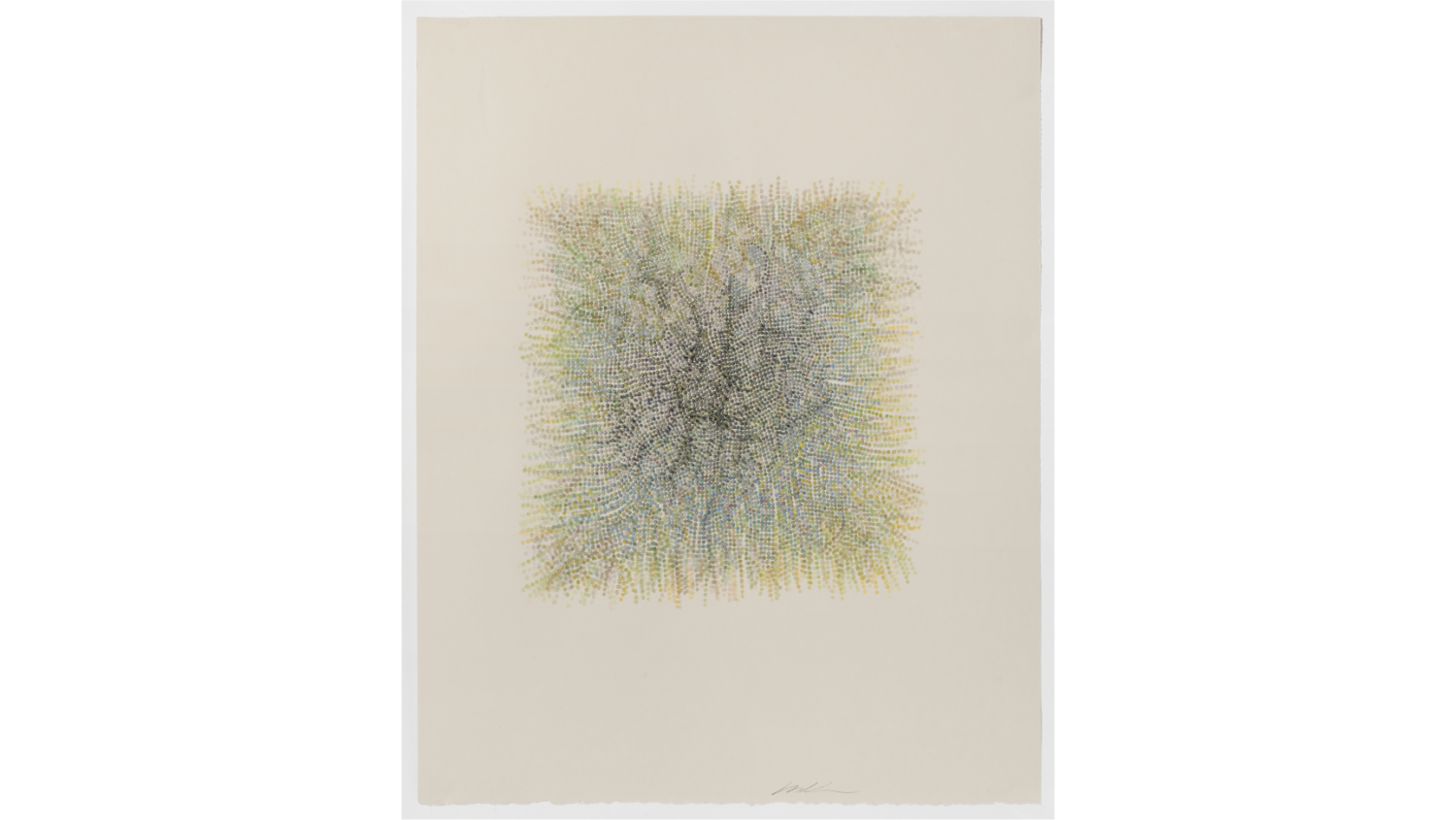
Highland. Material: Gouache on paper. Year: 2016. Size: 19 x 15 inches. Image courtesy of the artist and Gallery NAGA.
Born and raised in Japan, Masako Kamiya studied art at the Massachusetts College of Art in Boston and at Montserrat College of Art in Beverly, Massachusetts, where she is now an assistant professor. Her method of painting is unique, as well as time- and labor-intensive. She constructs tiny towers of pigment on paper, one dot of gouache (an opaque watercolor paint) at a time. As each daub of paint dries, she applies another, slowly building her three-dimensional surface. By the time a painting is finished, she will have repeated this process some 10,000 times. The slow build-up of pigment allows Kamiya to create subtle shifts of color both across the picture plane and projecting out from it. The images are abstract, but her process and colors can suggest topography and her titles allude to places or natural phenomenon.
Steve Locke
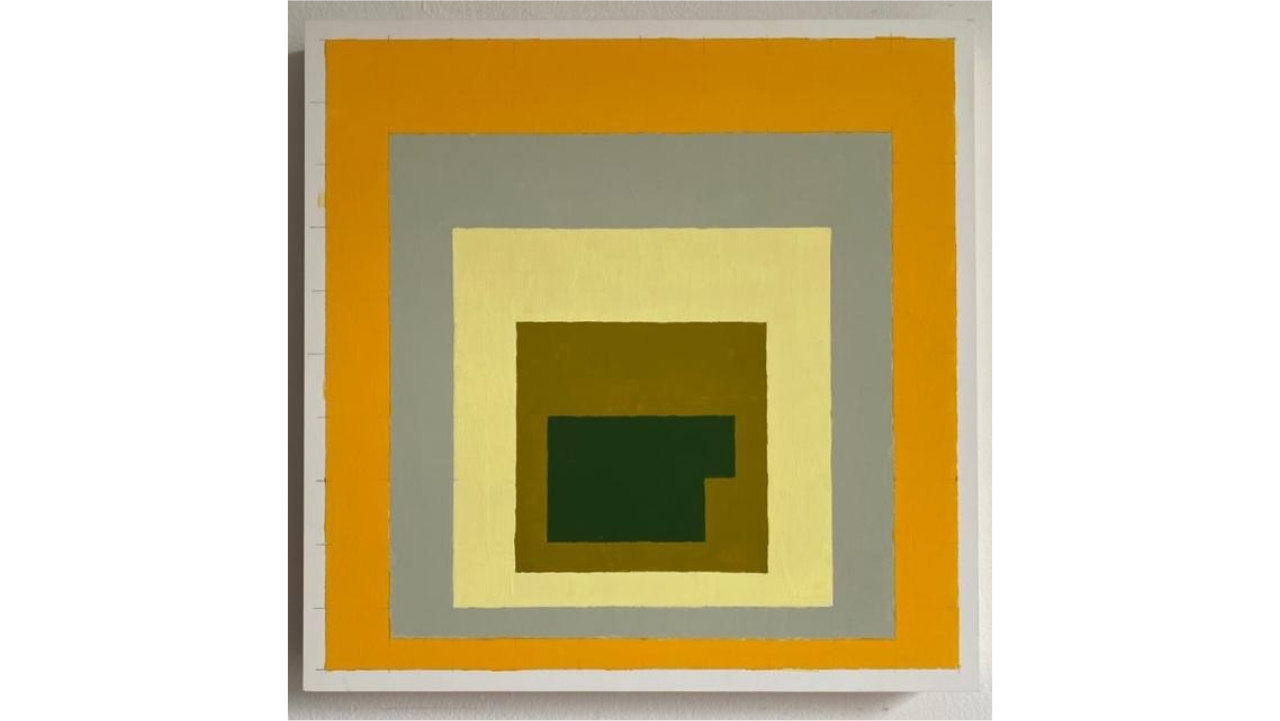
Homage to the Auction Block #38 – Fieldwork, 2020. Material: gouache on panel. Year: 2020. Size: 16 x 16 inches.
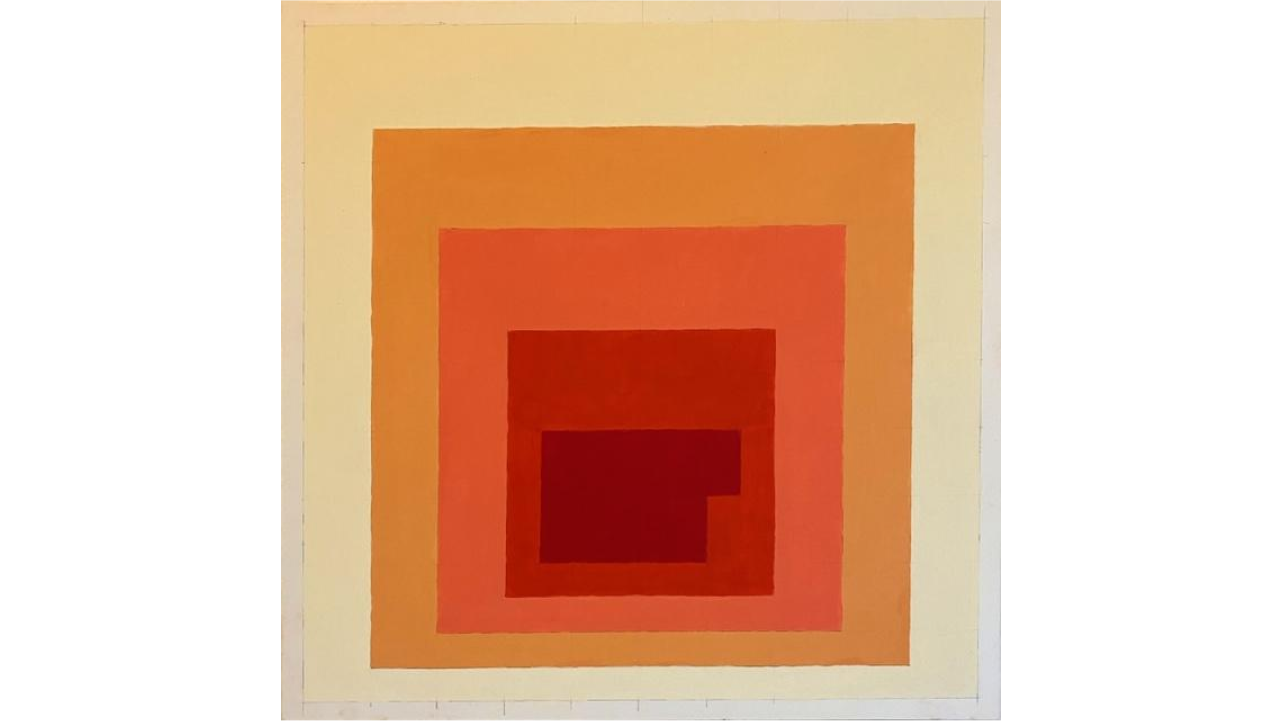
Homage to the Auction Block 26 Journey 2020. Material: gouache on panel. Year: 2020. Size: 16 x 16 inches.
American artist Steve Locke joined the faculty of the Pratt Institute in New York in the Fall of 2019. Before that, he was a Boston-based artist for over twenty years. He has been artist-in-residence at the Isabella Stewart Gardner Museum in Boston (2016) and for the City of Boston (2018). The series Homage to the Auction Block comes out of his artist’s residence with the city of Boston and a proposed public art piece for Faneuil Hall Auction Block Memorial. The proposal memorialized Africans kidnapped and sold by prominent 18th-century Boston slave trader and merchant Peter Faneuil with a heated bronze plaque embedded into the ground in the shape of an auction block. Locke withdrew the proposal when the Boston branch of the NAACP opposed the project.
Locke’s auction block form is a rectangle representing where the enslaved people would be held, with a jutting corner for the auctioneer. In this series of paintings, it serves as the center from which gradations of color radiate outwards. The series celebrates and critiques Josef Albers’ Homage to the Square, an icon of Western Modernism that distills painting to its fundamentals of form, color, and material. Locke’s paintings draw parallels between the centuries of erasure of the people sold at Faneuil Hall and elsewhere, with 20th-century modernists’ repudiation of centuries of art history in favor of notions of universality. As Cate McQuaid summarized in her Boston Globe review of Locke’s 2020 show of the series: “Locke puts those erased people, and indeed the dynamic of erasure, at the center of the picture plane and lets that history, and not the rigid and affectless square, be the dropped pebble from which colors ripple out.”
Silvia López Chavez
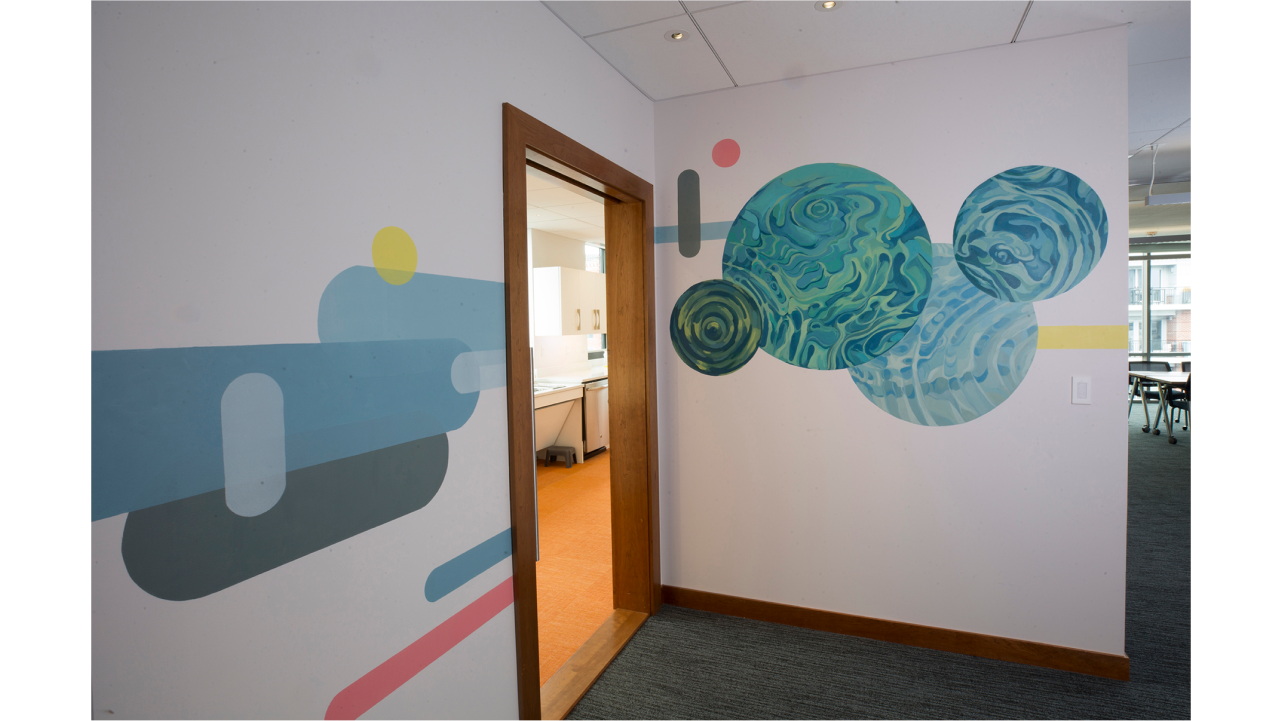
Rhythmic Nimbleness (detail). Material: site specific mural, acrylic on drywall. Year: 2018. Size: 8 1/2 x 118 feet.
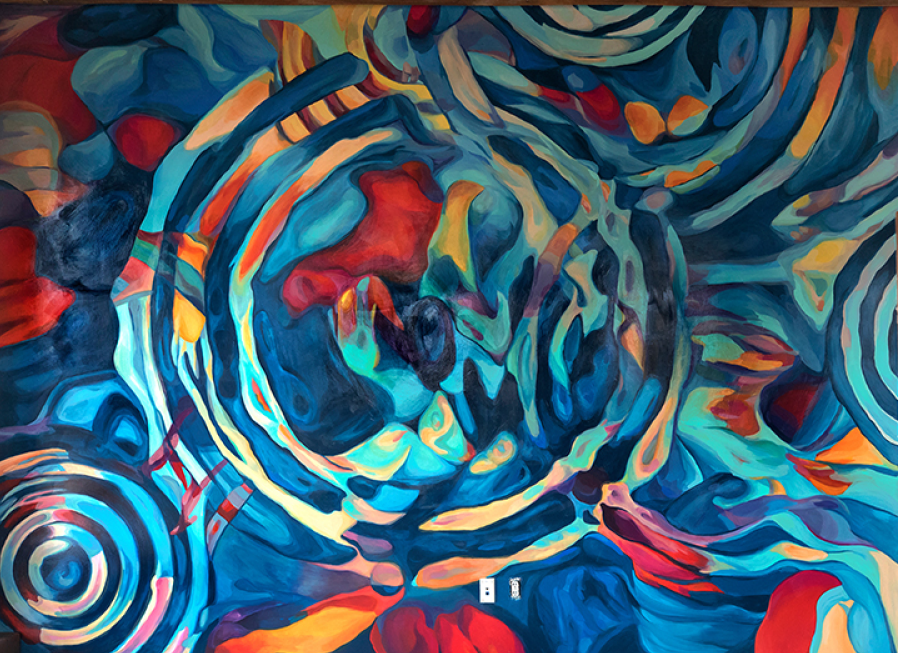
Ripples. Material: site specific mural, acrylic on drywall. Year: 2018. Size: 122 x 215 inches.
Boston-based artist Silvia López Chavez completed the North End Conference Room mural in July 2018. Her creative process is collaborative and community oriented. Through a series of conversations and meetings with Barr Foundation staff, Chavez identified several concepts for the mural: nurture, potential, collaboration, open, nimble. Its soft palette and rounded forms suggest the movement of water, which Chavez chose to signify Barr’s work because of its qualities of transparency, fluidity, life, and the sense of having a ripple effect of impact in a community. The semi-transparent forms overlap, visualizing the attributes of connection and collaboration. There are three focal points with stronger hues, one with botanical imagery is placed at the entrance to the conference room. This entrance point links the conference room space to the larger Barr Foundation office.
Chavez grew up in the Dominican Republic. She is active in the greater Boston community and a leader in utilizing art in the public realm as part of a social practice. For two years, she served as a Steering Committee member for the City of Boston Mayor’s Office to help shape the Boston Creates cultural plan for the city. Her public projects can be seen throughout Boston and on the North Shore.
Silvia López Chavez completed this mural in November 2018, following the installation of Rhythmic Nimbleness in July in the North End Conference Room. For her mural in this smaller, more relaxed space, Chavez focused on the ripples element in the prior mural and expanded the watery marks to cover an entire wall. A passionate colorist, she loosened the restraint on her palette as well. With its bold colors and overall composition, Ripples enlivens the space while harmonizing with the historic brickwork walls and cold Atlantic outside the windows.
Laura McPhee
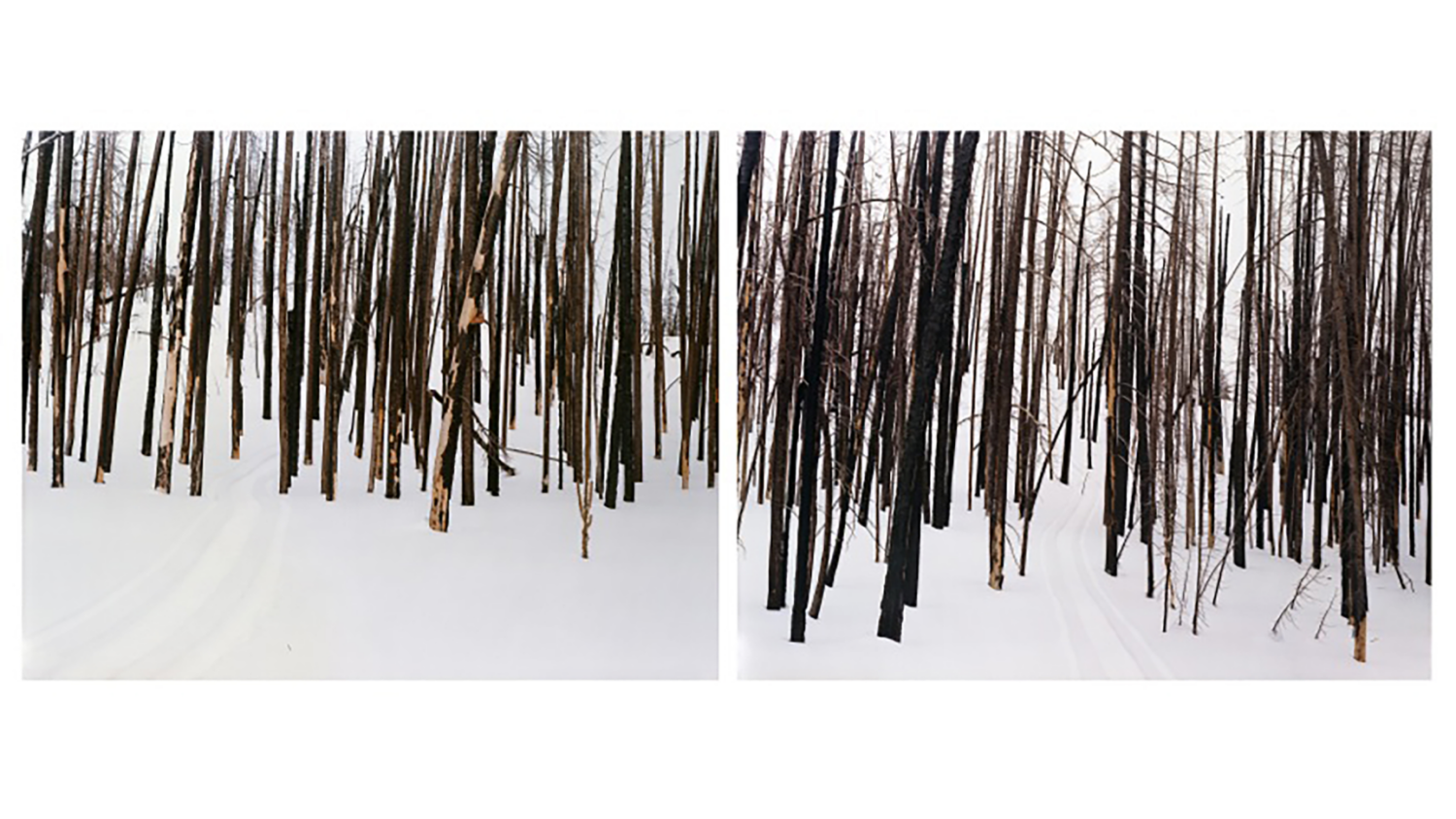
Midwinter Two Sides of One Hill. Material: Archival pigment print. Year: 2008. Size: Two panels, 40 x 50 inches each (101.6 x 127 cm). © Laura McPhee. Courtesy Carroll & Sons, Boston.
Boston-based photographer Laura McPhee is noted for her large-scale landscapes and portraits of the people who live and work in them. Her photographs chronicle the passage of time, both geologic and human. All contemplate the unintended consequences of humanity’s attempts to control and manage nature and how we use the earth and to what ends. Midwinter (Two Sides of One Hill) is part of a 2008 series made in three canyons in the White Cloud Mountains of central Idaho. As McPhee describes: “About three years earlier, on a windy early September day, a man burning a cardboard box in a burn barrel watched helplessly as sparks escaped and ignited the dry brush at his feet. Over the next two weeks, 40,838 acres of forest burned in a wildfire that was ultimately extinguished by snowfall.” The blackened tree trunks against white snow are a striking visualization of the immediate damage. Later compositions in the series depict the process of rejuvenation, as wild flowers and new growth return to the forest. The message overall of this series, Guardians of Solitude, is somber but the images are stunningly beautiful as their large-scale envelops the viewer.
Angel Otero
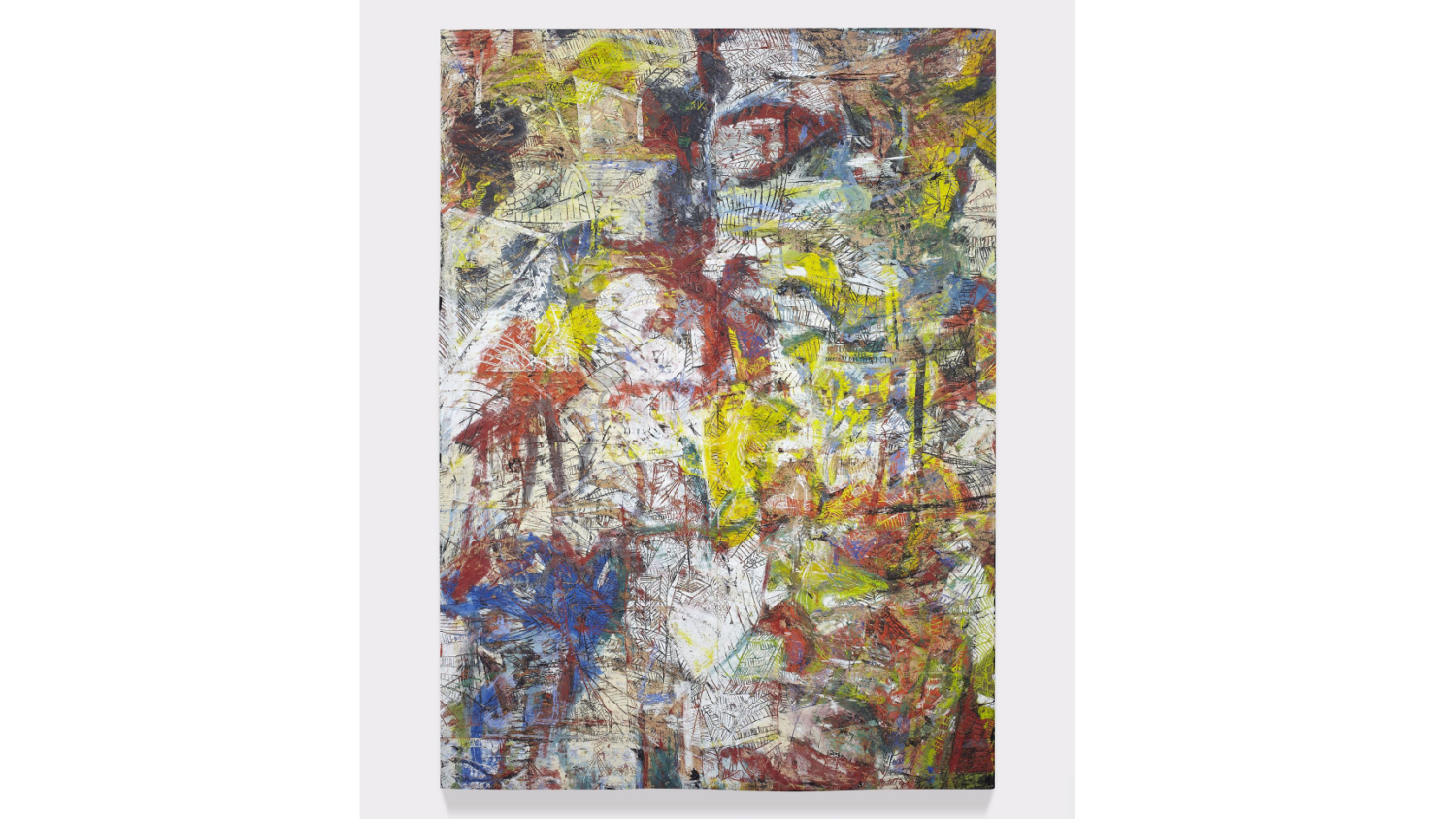
Shadows Dangled. Material: Oil paint and fabric collaged on canvas. Year: 2016 (signed and dated on verso). Size: 84 x 60 x 2 inches (213.4 x 152.4 x 5.1 cm). Courtesy the artist and Lehmann Maupin, New York and Hong Kong.
Puerto Rican-born, New York- and Chicago-based Angel Otero’s paintings initially appear to be direct descents of the Abstract Expressionist tradition. However, a close look at Shadows Dangled reveals a flat and slick surface of pigment and fabric laid onto the canvas frame, at times even overhanging the stretched canvas edges. These material anomalies lead viewers to consider Otero’s process of creation. He considers his unique painting process a form of narrative in itself. Otero begins by layering oil painting and fabric strips on a large glass pane. Once the pigment has dried, he scrapes and peels it off the glass, recomposing the “skins” on canvas. A central seam runs down the middle of this and most of his paintings, perhaps as a subtle nod to the unusual process behind the more traditional gestural mark-making. Otero is mining the history of 20th-century art, but his work is a constant negotiation between this history and the individual within and working after it.
Tim Rollins and K.O.S.
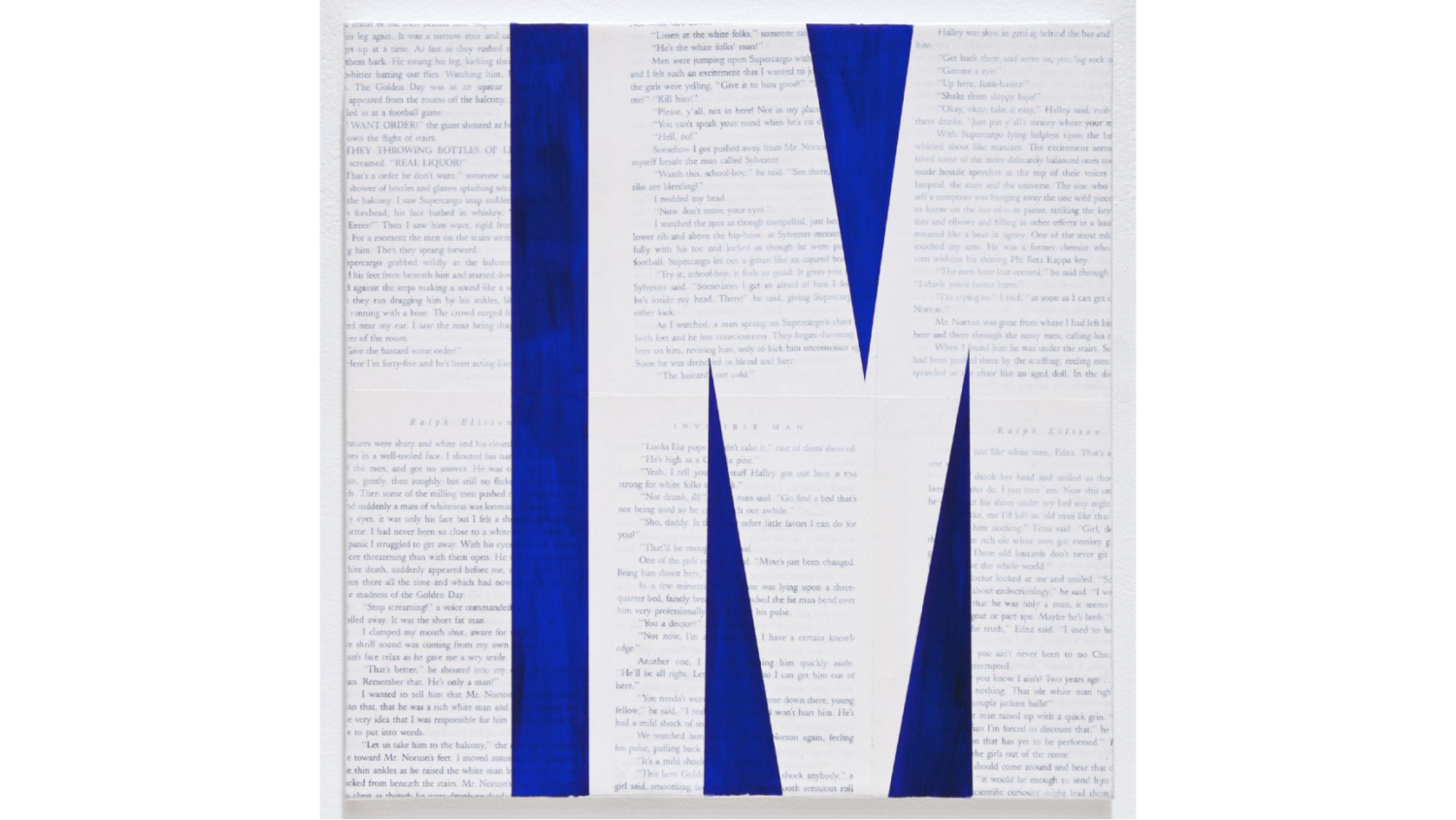
Invisible Man after Ralph Ellison. Material: India ink and pencil on book page. Year: 2012. Size: 12 x 12 inches (30.5 x 30.5 cm). Courtesy the artist and Lehmann Maupin, New York and Hong Kong.
Activist and artist Tim Rollins began teaching art to students deemed either academically or emotionally “at risk” in the South Bronx in 1981, with the idea of incorporating lessons in literature and writing. With his students he developed a process they call “jammin,” in which Rollins or a student would read aloud from classic literary texts while the others drew on those same pages, thereby recording their own responses and relating the text to their personal experience. They would cut out pages of text, laying the pages on one large canvas prior to beginning the process. The collective creation of the work is crucial and the students—who named themselves Kids Of Survival (K.O.S.)—have now moved through multiple generations. Rollins and K.O.S. long ago outgrew the classroom. Rollins opened an Art and Knowledge Workshop, an after-school program in a community center, and iterations of the workshop now exist in several cities across the United States. Invisible Man (after Ralph Ellison) is an example of Rollins’ and K.O.S.’s pioneering process, in which a socially engaged practice manifests in a beautiful and intellectually rigorous object.
Evelyn Rydz
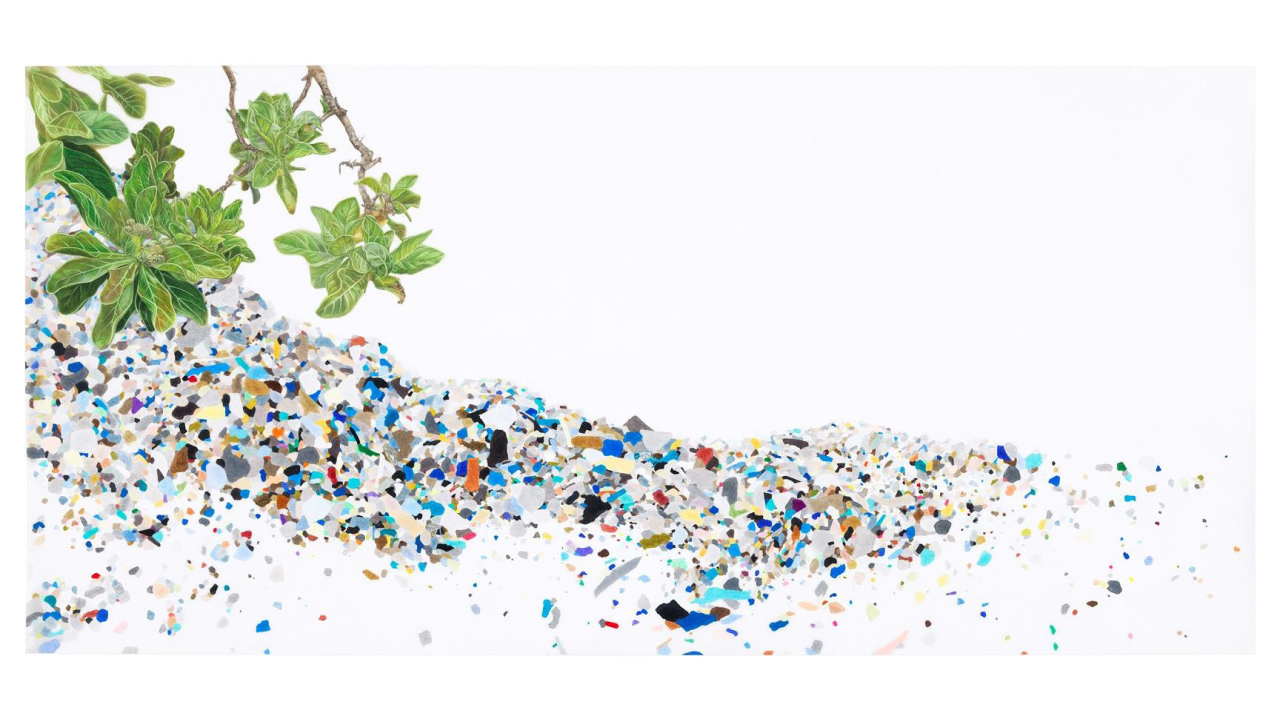
Natives. Material: Pencil and color pencil on Duralar. Year: 2017. Size: 20 x 42 inches.
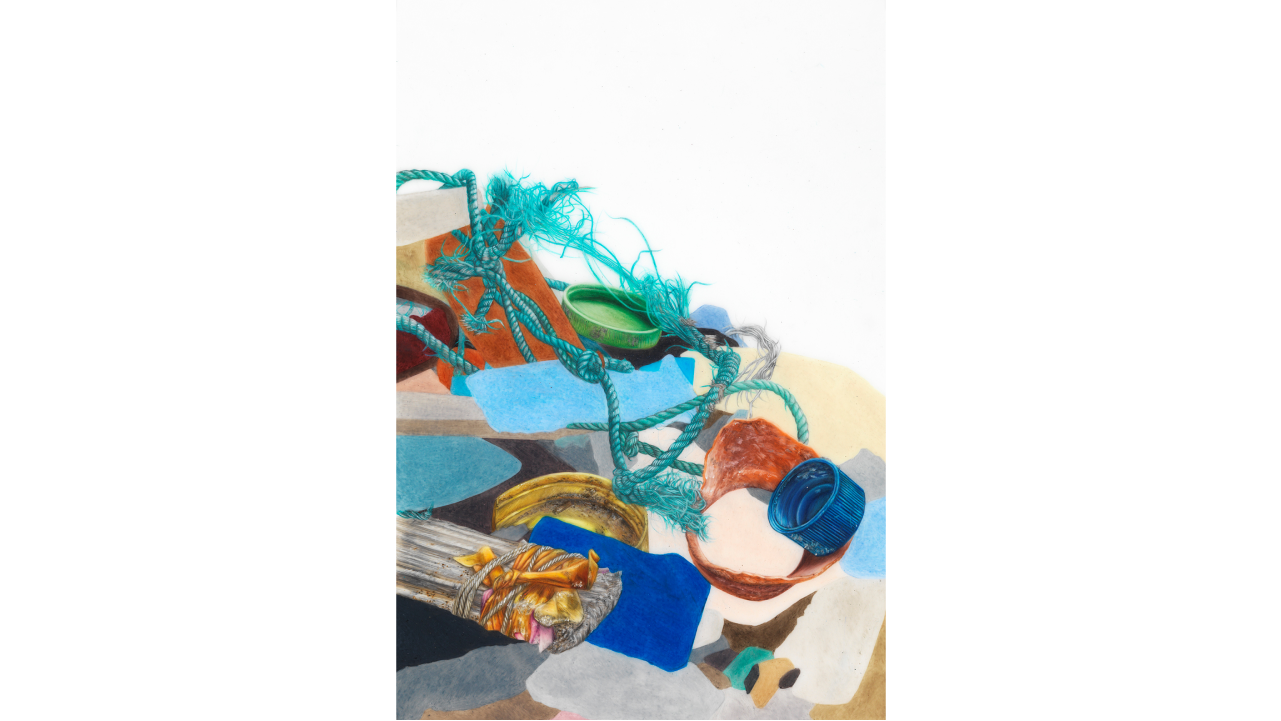
Untitled. Material: Pencil and color pencil on drafting film. Year: 2014. Size: 9.5 x 6.5 inches.
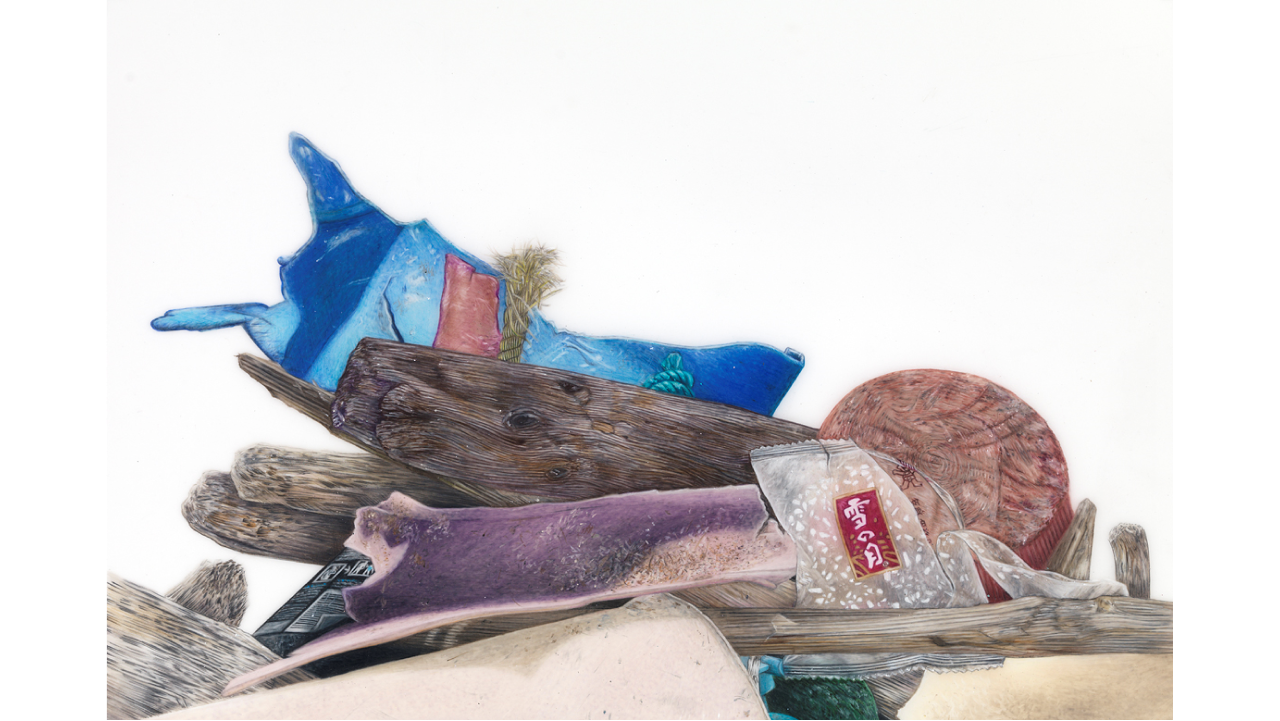
Bits and Pieces. Material: Pencil and color pencil on drafting film. Year: 2014. Size: 6 x 9 inches.
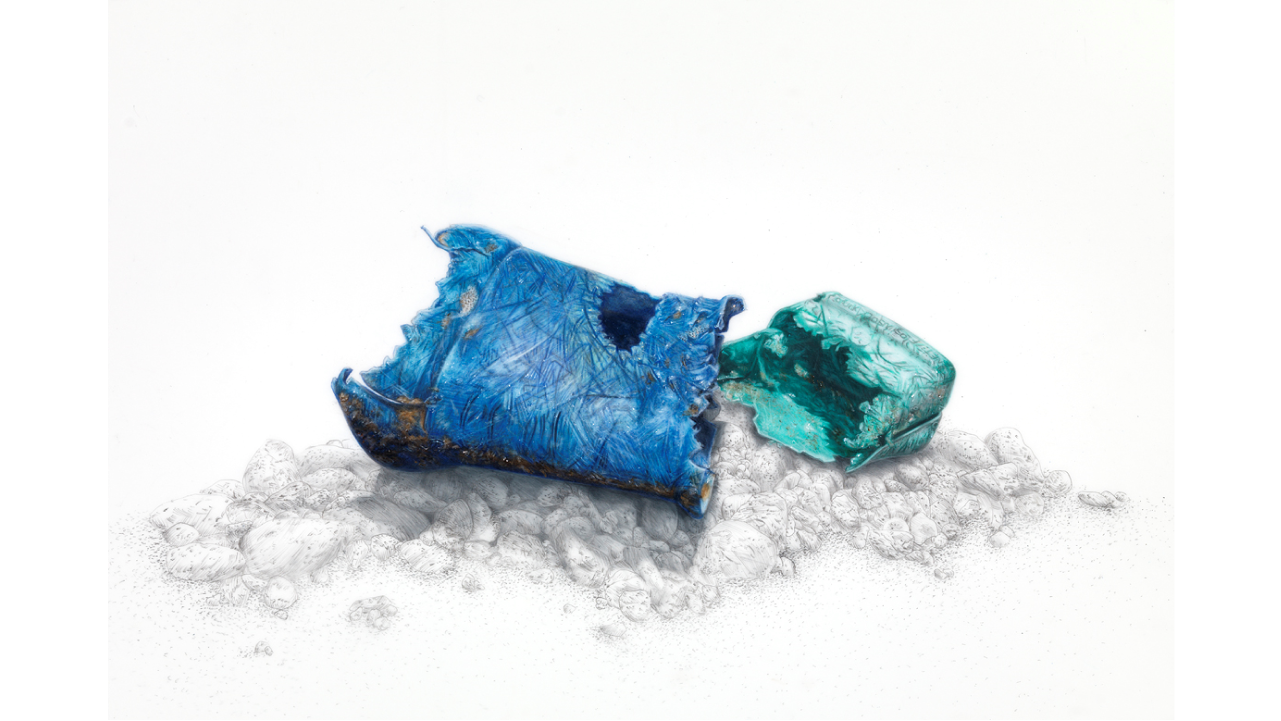
Fishbites. Material: Pencil and color pencil on drafting film. Year: 2014. Size: 6 x 9 inches.
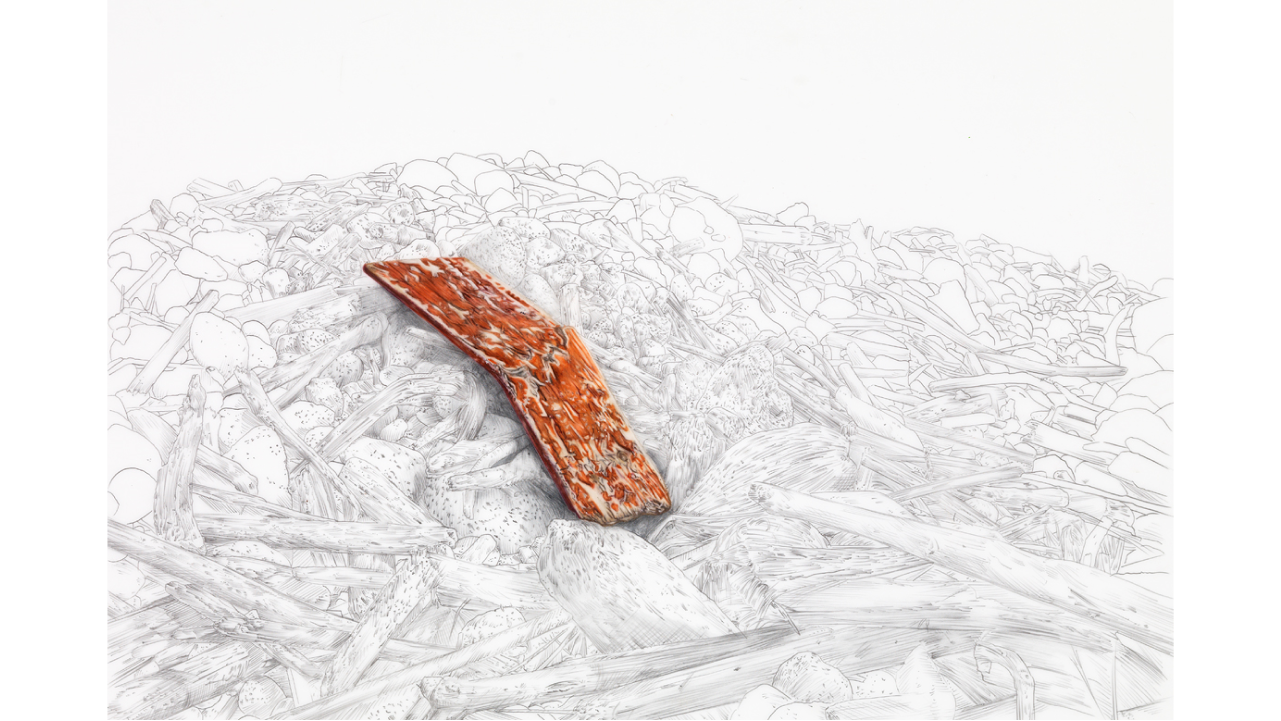
Plank with Driftwood. Material: Pencil and color pencil on drafting film. Year: 2014. Size: 6 x 9 inches.
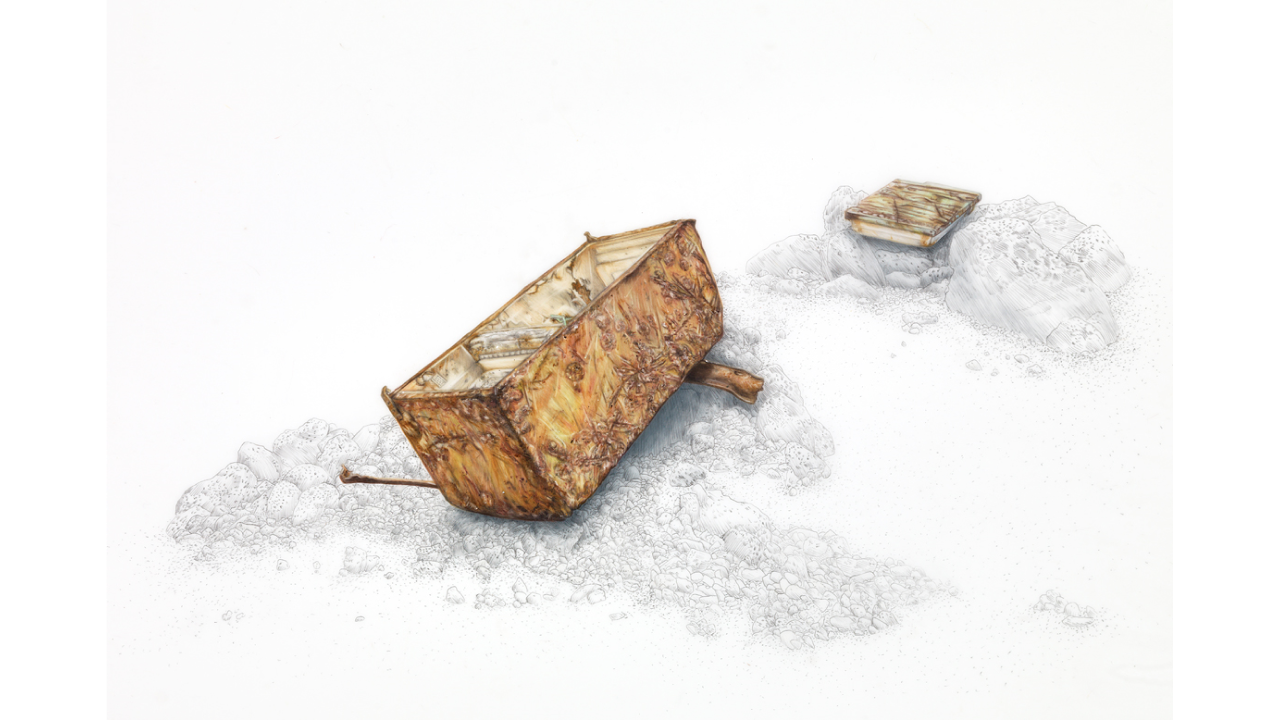
Rusted Fridge. Material: Pencil and color pencil on drafting film. Year: 2014. Size: 6 x 9 inches. © Evelyn Rydz, image courtesy Ellen Miller Gallery.
In Natives, Rydz’s story continues and literally foregrounds the environment’s attempts to reclaim the multi-colored grains with new plant growth. She has worked with drawing, photography, video, and sound to explore this theme. She is prominent in the Boston community, having led community art projects at the Museum of Fine Arts and the Institute of Contemporary Art, as well as the Museum of Contemporary Art, Miami.
In 2012, Rydz received the School of the Museum of Fine Arts, Boston’s prestigious Traveling Scholars Fellowship, allowing her to expand her research beyond the Atlantic. She traveled to Kamilo Beach, Hawaii, known for its accumulation of plastic marine debris from the currents creating the Great Pacific Garbage Patch. She says, “I walked for days through massive amounts of debris and plastic sands feeling like an archaeologist excavating the residues of contemporary history.” She terms the small drawings she completed based on her photographs from this excavation “postcards.” They have the feel of archeological specimens from a strange land or unknown time. The project was the subject of a solo exhibition at the Museum of Fine Arts, Boston, in 2014.
Boston-based artist Evelyn Rydz creates masterful drawings based on her photographs of detritus that wash up on beaches. She is particularly fascinated by plastic, highly valued in modern society for its durability but useless and equally permanent when it enters an ocean ecosystem. Rydz identifies the narratives of these displaced plastics, tracing their movement in ocean currents, their softening and whittling forms that eventually appear tossed up on the shore.
Nari Ward
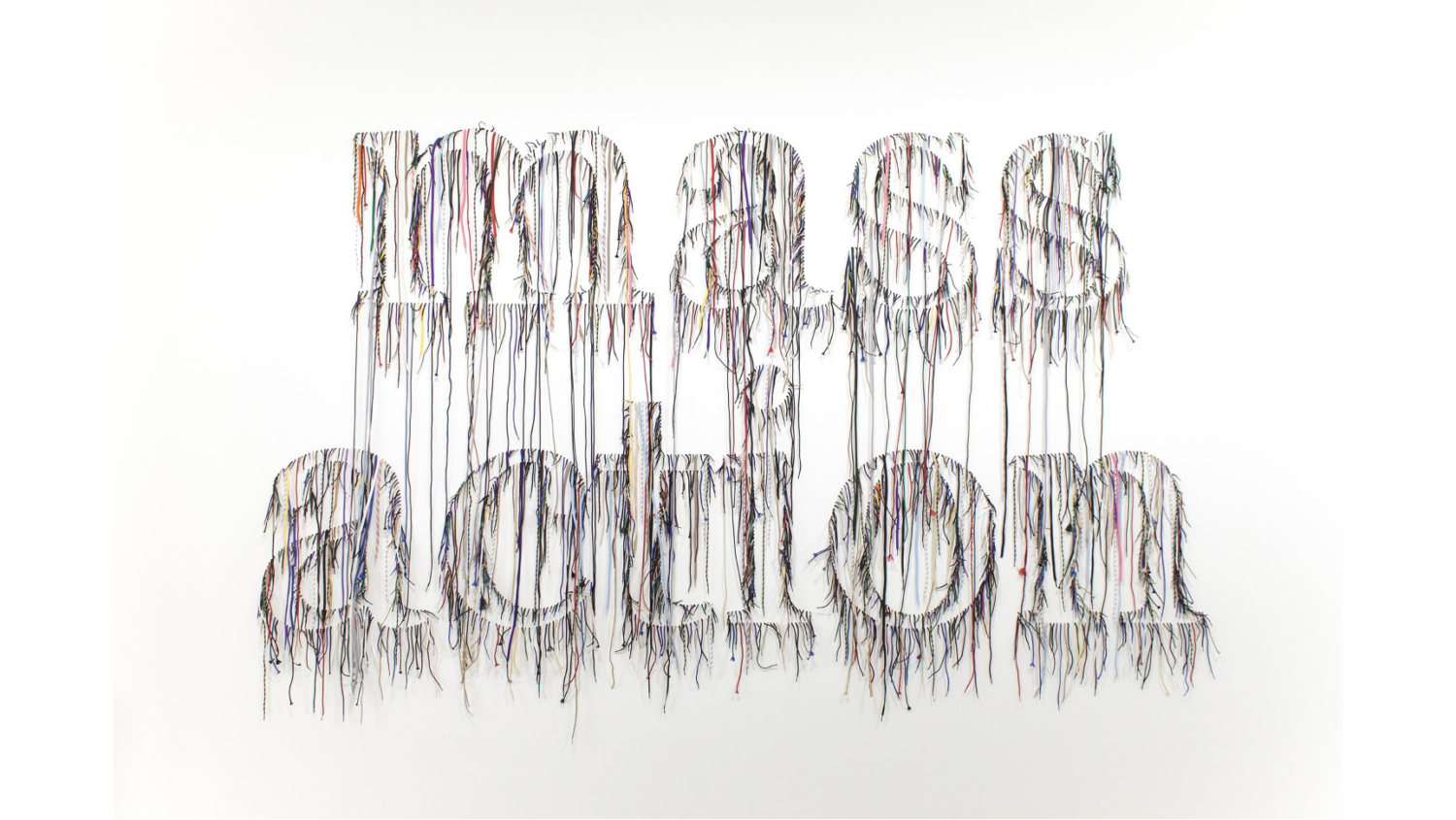
Mass action. Material: shoelaces. Year: 2016. Size: 84 x 130 x 2 inches (213.4 x 330.2x 5.1 cm). Courtesy the artist and Lehmann Maupin, New York and Hong Kong.
Jamaican-born, Harlem-based Nari Ward creates art using found urban material that invites a dialogue about race and immigration, poverty and power, and economics and consumer culture. In 2011, Ward created a first textile installation composed of nearly 1,000 shoelaces spelling out “We the People.” That installation was recreated earlier this year using community-donated shoelaces and will hang permanently in the New York Historical Society. Like mass action, it is a broad call for engagement at a moment of deep social and political divide in the United States. Shoelaces have become a common material for Ward. They are available to and knowable by all. Formally the laces act as a line, facilitating the artist’s interest in drawing and mark-making. In these installations, Ward attends to details such as font, color, and scale to provoke both an intimate conversation with a single viewer and a broader discourse. In the Barr Foundation’s context, mass action signals both the Foundation’s commitment to supporting an inclusive community and its roots and dedication to the concerns of the Commonwealth of Massachusetts.
Suara Welitoff
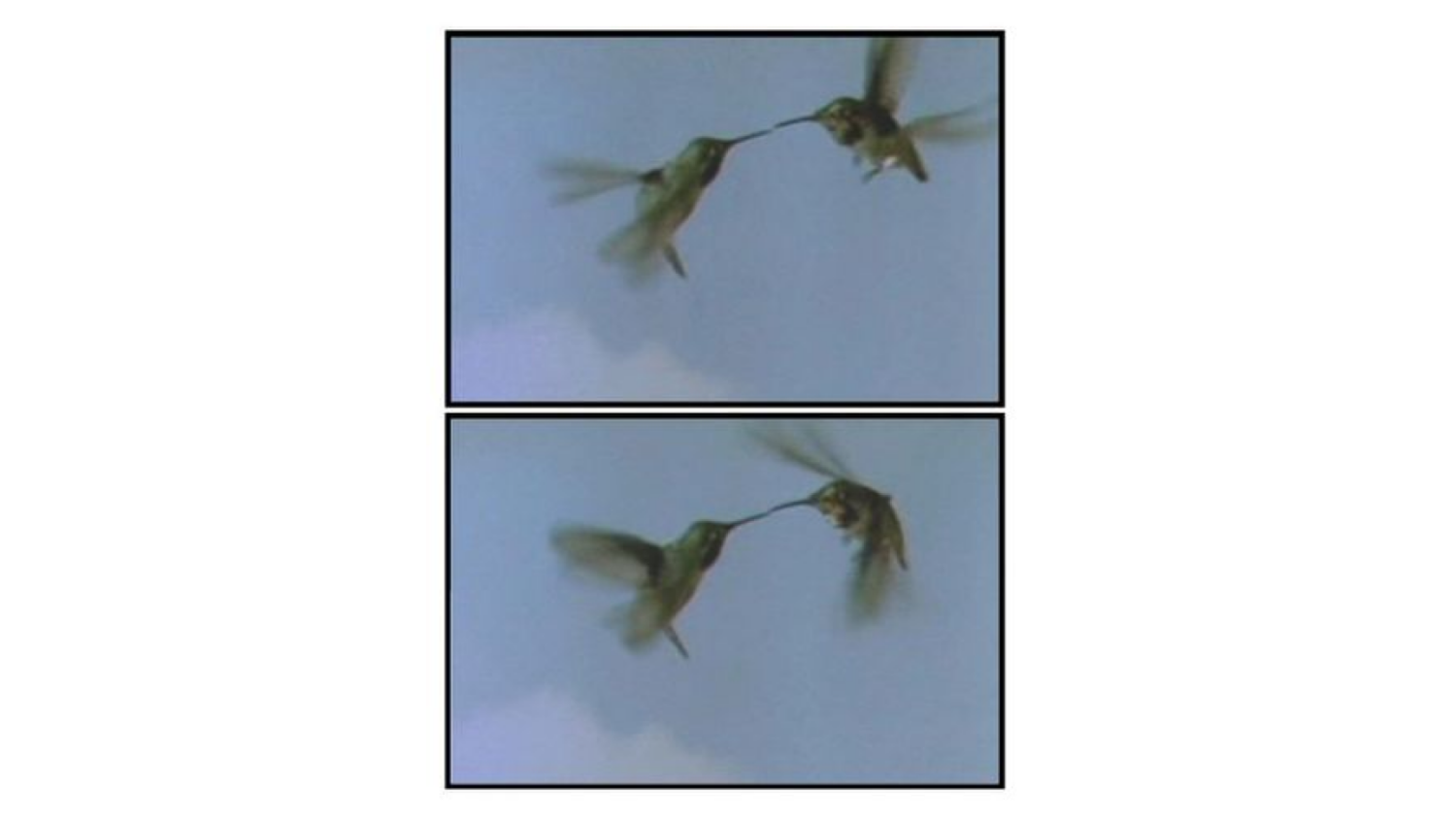
Kiss. Material: Continuously looping video (silent). Year: 2010. Size: Variable. © 2017 the artist, image courtesy of Krakow Witkin Gallery, Boston.
New England-based Suara Welitoff uses existing film and film-footage to create brief, looped scenes devoid of time, context, and space. Her videos have been variously termed “mechanical watercolors” or “video poems.” Welitoff has stated that she approaches making video as if she were a painter. Rather than pursuing a narrative arc with the time-based medium, her low definition slowed-down clips function in a space of ambiguity. Their subtle coloration and slight un-focus evoke a sense of nostalgia and time passed. Kiss allows us to see in slow motion the coming together and then moving apart of two hummingbirds in mid-flight. To mesmerizing effect, it enlarges something small, slows down something rapid and allows us a studied contemplation of something not possible in nature.